Resource Planning and Management Assignment
VerifiedAdded on 2021/04/24
|19
|5207
|206
AI Summary
This assignment delves into the essential aspects of resource planning and management, including strategic implementation, policy management, and resource integration. It requires students to analyze the importance of these concepts in optimizing resource utilization for effective project execution. By examining real-world examples and theoretical frameworks, such as service-dominant logic and constraint satisfaction theories, students will gain a deeper understanding of how to develop and implement resource plans that ensure successful project outcomes.
Contribute Materials
Your contribution can guide someone’s learning journey. Share your
documents today.
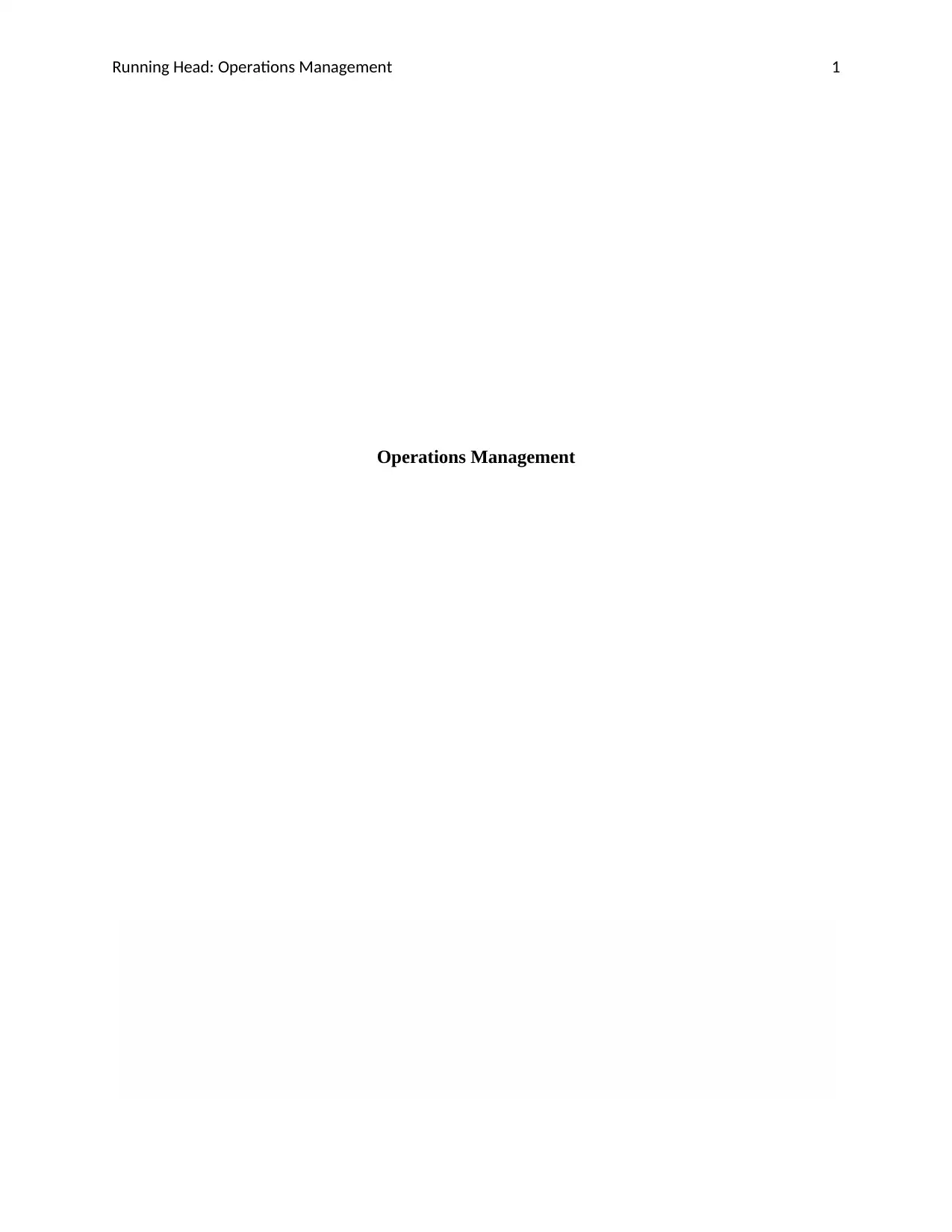
Running Head: Operations Management 1
Operations Management
Operations Management
Secure Best Marks with AI Grader
Need help grading? Try our AI Grader for instant feedback on your assignments.
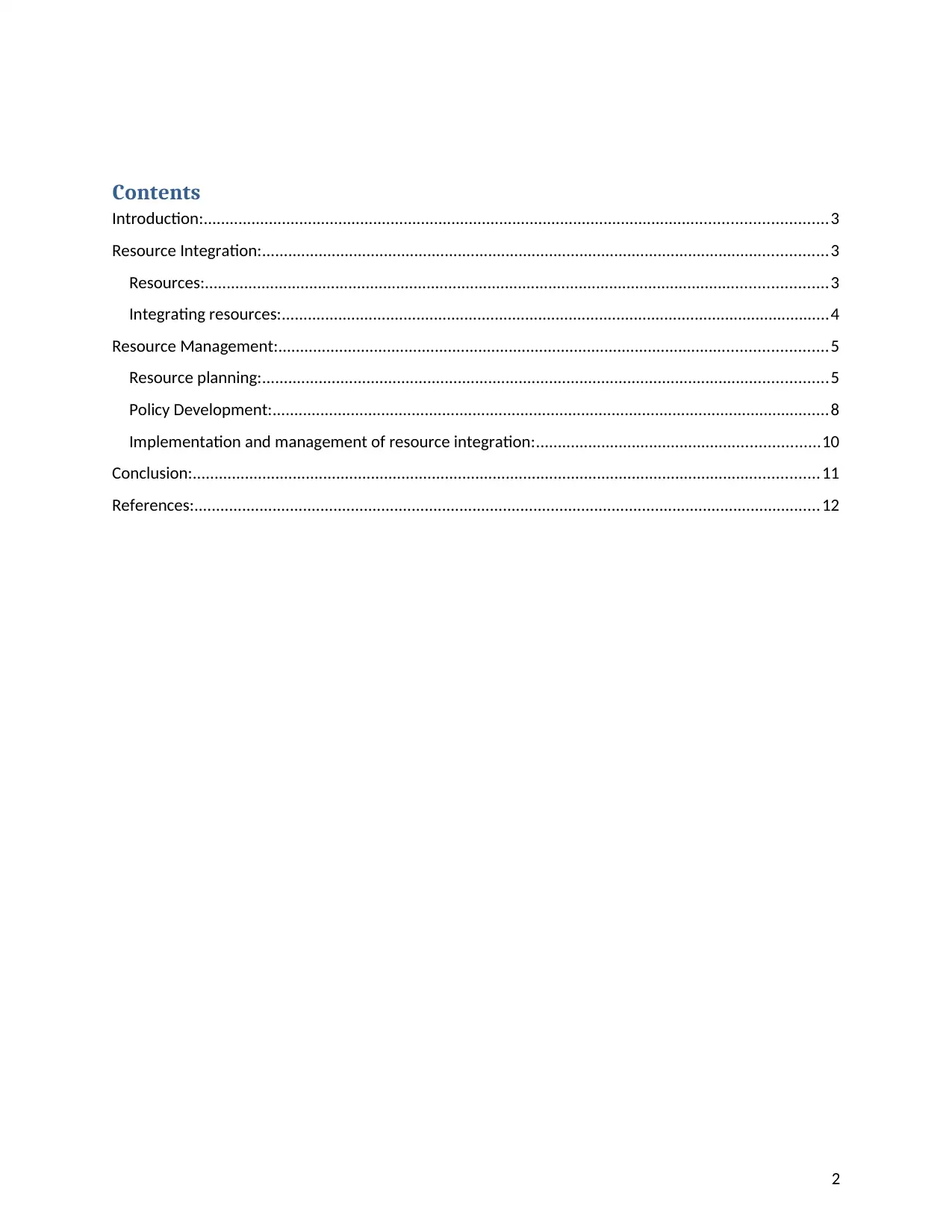
Contents
Introduction:...............................................................................................................................................3
Resource Integration:..................................................................................................................................3
Resources:...............................................................................................................................................3
Integrating resources:..............................................................................................................................4
Resource Management:..............................................................................................................................5
Resource planning:..................................................................................................................................5
Policy Development:................................................................................................................................8
Implementation and management of resource integration:.................................................................10
Conclusion:................................................................................................................................................11
References:................................................................................................................................................12
2
Introduction:...............................................................................................................................................3
Resource Integration:..................................................................................................................................3
Resources:...............................................................................................................................................3
Integrating resources:..............................................................................................................................4
Resource Management:..............................................................................................................................5
Resource planning:..................................................................................................................................5
Policy Development:................................................................................................................................8
Implementation and management of resource integration:.................................................................10
Conclusion:................................................................................................................................................11
References:................................................................................................................................................12
2
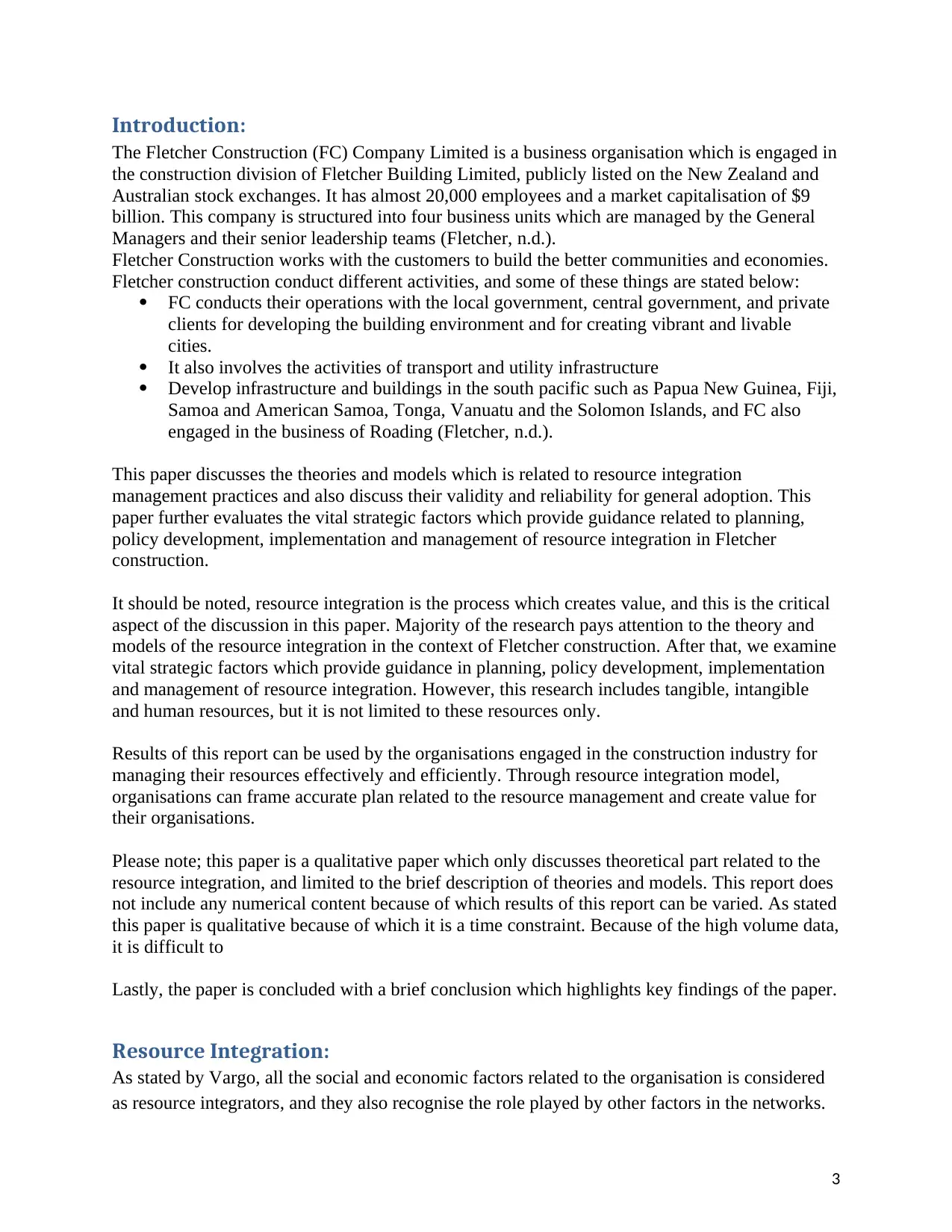
Introduction:
The Fletcher Construction (FC) Company Limited is a business organisation which is engaged in
the construction division of Fletcher Building Limited, publicly listed on the New Zealand and
Australian stock exchanges. It has almost 20,000 employees and a market capitalisation of $9
billion. This company is structured into four business units which are managed by the General
Managers and their senior leadership teams (Fletcher, n.d.).
Fletcher Construction works with the customers to build the better communities and economies.
Fletcher construction conduct different activities, and some of these things are stated below:
FC conducts their operations with the local government, central government, and private
clients for developing the building environment and for creating vibrant and livable
cities.
It also involves the activities of transport and utility infrastructure
Develop infrastructure and buildings in the south pacific such as Papua New Guinea, Fiji,
Samoa and American Samoa, Tonga, Vanuatu and the Solomon Islands, and FC also
engaged in the business of Roading (Fletcher, n.d.).
This paper discusses the theories and models which is related to resource integration
management practices and also discuss their validity and reliability for general adoption. This
paper further evaluates the vital strategic factors which provide guidance related to planning,
policy development, implementation and management of resource integration in Fletcher
construction.
It should be noted, resource integration is the process which creates value, and this is the critical
aspect of the discussion in this paper. Majority of the research pays attention to the theory and
models of the resource integration in the context of Fletcher construction. After that, we examine
vital strategic factors which provide guidance in planning, policy development, implementation
and management of resource integration. However, this research includes tangible, intangible
and human resources, but it is not limited to these resources only.
Results of this report can be used by the organisations engaged in the construction industry for
managing their resources effectively and efficiently. Through resource integration model,
organisations can frame accurate plan related to the resource management and create value for
their organisations.
Please note; this paper is a qualitative paper which only discusses theoretical part related to the
resource integration, and limited to the brief description of theories and models. This report does
not include any numerical content because of which results of this report can be varied. As stated
this paper is qualitative because of which it is a time constraint. Because of the high volume data,
it is difficult to
Lastly, the paper is concluded with a brief conclusion which highlights key findings of the paper.
Resource Integration:
As stated by Vargo, all the social and economic factors related to the organisation is considered
as resource integrators, and they also recognise the role played by other factors in the networks.
3
The Fletcher Construction (FC) Company Limited is a business organisation which is engaged in
the construction division of Fletcher Building Limited, publicly listed on the New Zealand and
Australian stock exchanges. It has almost 20,000 employees and a market capitalisation of $9
billion. This company is structured into four business units which are managed by the General
Managers and their senior leadership teams (Fletcher, n.d.).
Fletcher Construction works with the customers to build the better communities and economies.
Fletcher construction conduct different activities, and some of these things are stated below:
FC conducts their operations with the local government, central government, and private
clients for developing the building environment and for creating vibrant and livable
cities.
It also involves the activities of transport and utility infrastructure
Develop infrastructure and buildings in the south pacific such as Papua New Guinea, Fiji,
Samoa and American Samoa, Tonga, Vanuatu and the Solomon Islands, and FC also
engaged in the business of Roading (Fletcher, n.d.).
This paper discusses the theories and models which is related to resource integration
management practices and also discuss their validity and reliability for general adoption. This
paper further evaluates the vital strategic factors which provide guidance related to planning,
policy development, implementation and management of resource integration in Fletcher
construction.
It should be noted, resource integration is the process which creates value, and this is the critical
aspect of the discussion in this paper. Majority of the research pays attention to the theory and
models of the resource integration in the context of Fletcher construction. After that, we examine
vital strategic factors which provide guidance in planning, policy development, implementation
and management of resource integration. However, this research includes tangible, intangible
and human resources, but it is not limited to these resources only.
Results of this report can be used by the organisations engaged in the construction industry for
managing their resources effectively and efficiently. Through resource integration model,
organisations can frame accurate plan related to the resource management and create value for
their organisations.
Please note; this paper is a qualitative paper which only discusses theoretical part related to the
resource integration, and limited to the brief description of theories and models. This report does
not include any numerical content because of which results of this report can be varied. As stated
this paper is qualitative because of which it is a time constraint. Because of the high volume data,
it is difficult to
Lastly, the paper is concluded with a brief conclusion which highlights key findings of the paper.
Resource Integration:
As stated by Vargo, all the social and economic factors related to the organisation is considered
as resource integrators, and they also recognise the role played by other factors in the networks.
3
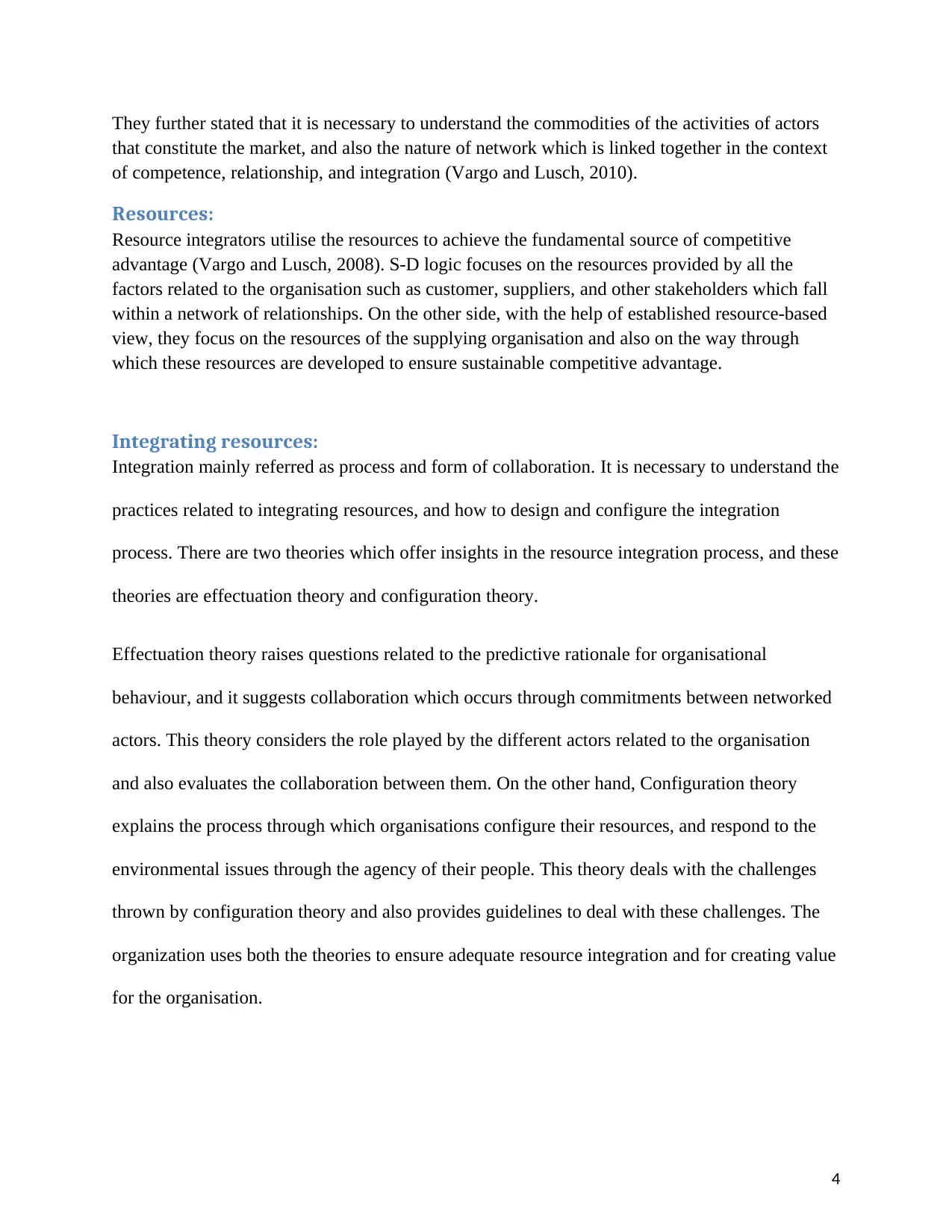
They further stated that it is necessary to understand the commodities of the activities of actors
that constitute the market, and also the nature of network which is linked together in the context
of competence, relationship, and integration (Vargo and Lusch, 2010).
Resources:
Resource integrators utilise the resources to achieve the fundamental source of competitive
advantage (Vargo and Lusch, 2008). S-D logic focuses on the resources provided by all the
factors related to the organisation such as customer, suppliers, and other stakeholders which fall
within a network of relationships. On the other side, with the help of established resource-based
view, they focus on the resources of the supplying organisation and also on the way through
which these resources are developed to ensure sustainable competitive advantage.
Integrating resources:
Integration mainly referred as process and form of collaboration. It is necessary to understand the
practices related to integrating resources, and how to design and configure the integration
process. There are two theories which offer insights in the resource integration process, and these
theories are effectuation theory and configuration theory.
Effectuation theory raises questions related to the predictive rationale for organisational
behaviour, and it suggests collaboration which occurs through commitments between networked
actors. This theory considers the role played by the different actors related to the organisation
and also evaluates the collaboration between them. On the other hand, Configuration theory
explains the process through which organisations configure their resources, and respond to the
environmental issues through the agency of their people. This theory deals with the challenges
thrown by configuration theory and also provides guidelines to deal with these challenges. The
organization uses both the theories to ensure adequate resource integration and for creating value
for the organisation.
4
that constitute the market, and also the nature of network which is linked together in the context
of competence, relationship, and integration (Vargo and Lusch, 2010).
Resources:
Resource integrators utilise the resources to achieve the fundamental source of competitive
advantage (Vargo and Lusch, 2008). S-D logic focuses on the resources provided by all the
factors related to the organisation such as customer, suppliers, and other stakeholders which fall
within a network of relationships. On the other side, with the help of established resource-based
view, they focus on the resources of the supplying organisation and also on the way through
which these resources are developed to ensure sustainable competitive advantage.
Integrating resources:
Integration mainly referred as process and form of collaboration. It is necessary to understand the
practices related to integrating resources, and how to design and configure the integration
process. There are two theories which offer insights in the resource integration process, and these
theories are effectuation theory and configuration theory.
Effectuation theory raises questions related to the predictive rationale for organisational
behaviour, and it suggests collaboration which occurs through commitments between networked
actors. This theory considers the role played by the different actors related to the organisation
and also evaluates the collaboration between them. On the other hand, Configuration theory
explains the process through which organisations configure their resources, and respond to the
environmental issues through the agency of their people. This theory deals with the challenges
thrown by configuration theory and also provides guidelines to deal with these challenges. The
organization uses both the theories to ensure adequate resource integration and for creating value
for the organisation.
4
Secure Best Marks with AI Grader
Need help grading? Try our AI Grader for instant feedback on your assignments.
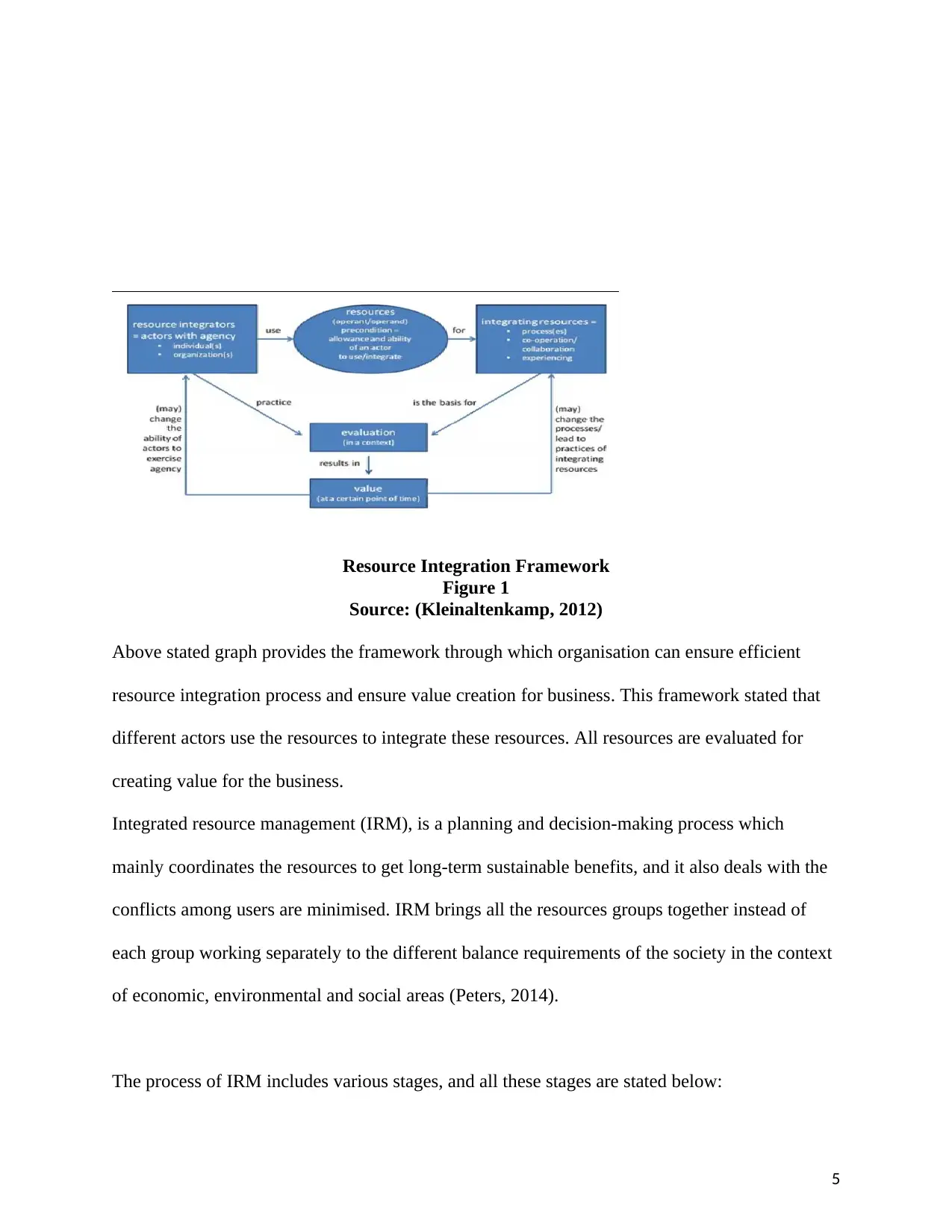
Resource Integration Framework
Figure 1
Source: (Kleinaltenkamp, 2012)
Above stated graph provides the framework through which organisation can ensure efficient
resource integration process and ensure value creation for business. This framework stated that
different actors use the resources to integrate these resources. All resources are evaluated for
creating value for the business.
Integrated resource management (IRM), is a planning and decision-making process which
mainly coordinates the resources to get long-term sustainable benefits, and it also deals with the
conflicts among users are minimised. IRM brings all the resources groups together instead of
each group working separately to the different balance requirements of the society in the context
of economic, environmental and social areas (Peters, 2014).
The process of IRM includes various stages, and all these stages are stated below:
5
Figure 1
Source: (Kleinaltenkamp, 2012)
Above stated graph provides the framework through which organisation can ensure efficient
resource integration process and ensure value creation for business. This framework stated that
different actors use the resources to integrate these resources. All resources are evaluated for
creating value for the business.
Integrated resource management (IRM), is a planning and decision-making process which
mainly coordinates the resources to get long-term sustainable benefits, and it also deals with the
conflicts among users are minimised. IRM brings all the resources groups together instead of
each group working separately to the different balance requirements of the society in the context
of economic, environmental and social areas (Peters, 2014).
The process of IRM includes various stages, and all these stages are stated below:
5
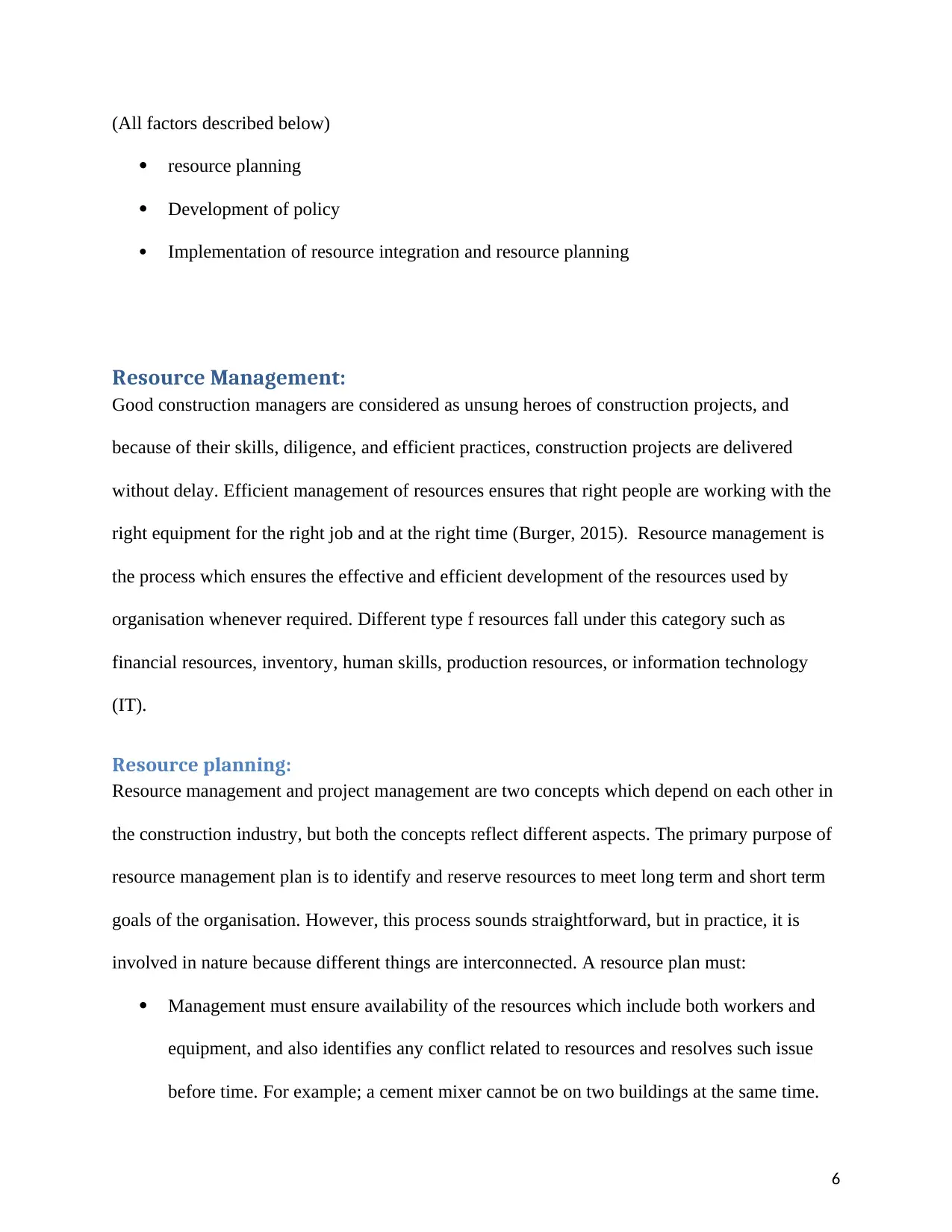
(All factors described below)
resource planning
Development of policy
Implementation of resource integration and resource planning
Resource Management:
Good construction managers are considered as unsung heroes of construction projects, and
because of their skills, diligence, and efficient practices, construction projects are delivered
without delay. Efficient management of resources ensures that right people are working with the
right equipment for the right job and at the right time (Burger, 2015). Resource management is
the process which ensures the effective and efficient development of the resources used by
organisation whenever required. Different type f resources fall under this category such as
financial resources, inventory, human skills, production resources, or information technology
(IT).
Resource planning:
Resource management and project management are two concepts which depend on each other in
the construction industry, but both the concepts reflect different aspects. The primary purpose of
resource management plan is to identify and reserve resources to meet long term and short term
goals of the organisation. However, this process sounds straightforward, but in practice, it is
involved in nature because different things are interconnected. A resource plan must:
Management must ensure availability of the resources which include both workers and
equipment, and also identifies any conflict related to resources and resolves such issue
before time. For example; a cement mixer cannot be on two buildings at the same time.
6
resource planning
Development of policy
Implementation of resource integration and resource planning
Resource Management:
Good construction managers are considered as unsung heroes of construction projects, and
because of their skills, diligence, and efficient practices, construction projects are delivered
without delay. Efficient management of resources ensures that right people are working with the
right equipment for the right job and at the right time (Burger, 2015). Resource management is
the process which ensures the effective and efficient development of the resources used by
organisation whenever required. Different type f resources fall under this category such as
financial resources, inventory, human skills, production resources, or information technology
(IT).
Resource planning:
Resource management and project management are two concepts which depend on each other in
the construction industry, but both the concepts reflect different aspects. The primary purpose of
resource management plan is to identify and reserve resources to meet long term and short term
goals of the organisation. However, this process sounds straightforward, but in practice, it is
involved in nature because different things are interconnected. A resource plan must:
Management must ensure availability of the resources which include both workers and
equipment, and also identifies any conflict related to resources and resolves such issue
before time. For example; a cement mixer cannot be on two buildings at the same time.
6
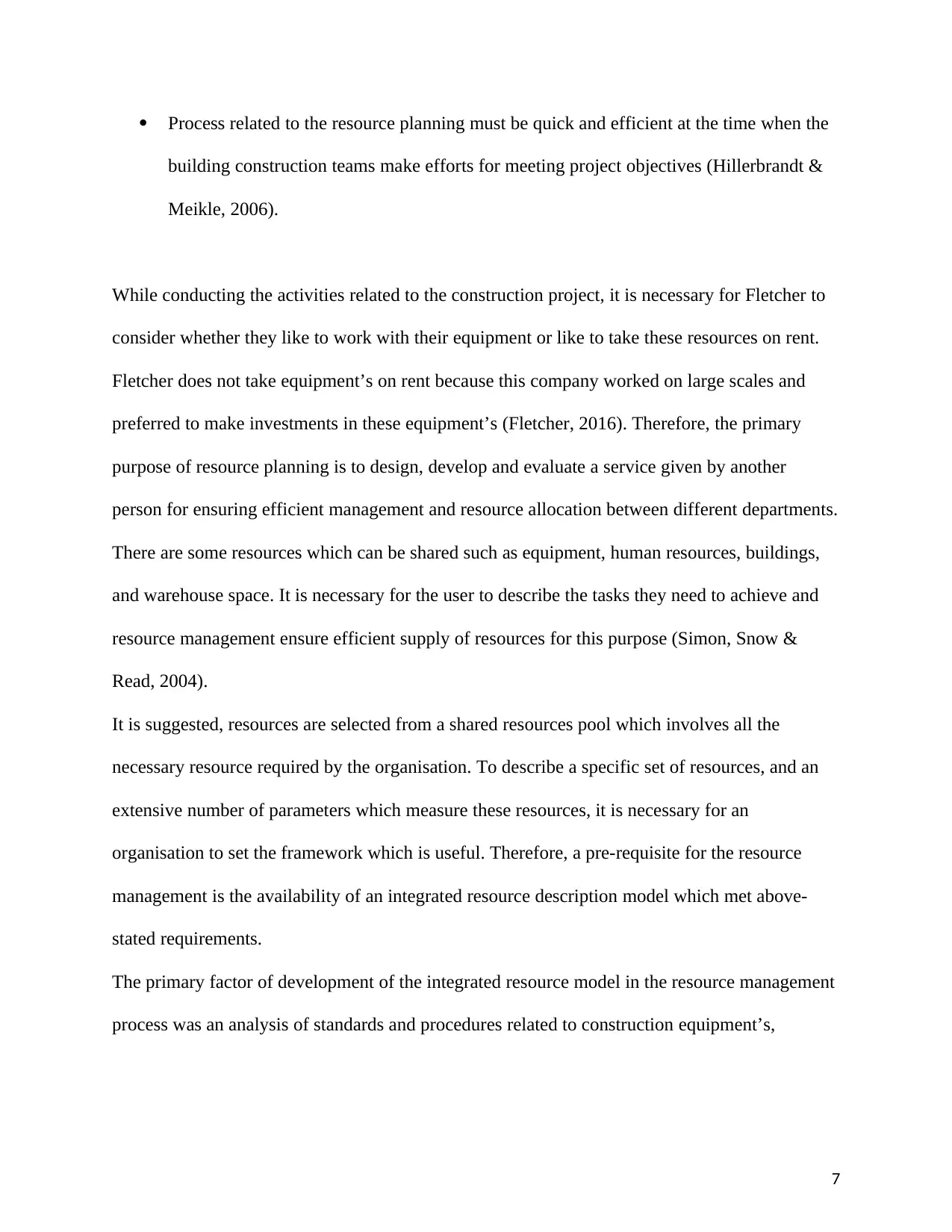
Process related to the resource planning must be quick and efficient at the time when the
building construction teams make efforts for meeting project objectives (Hillerbrandt &
Meikle, 2006).
While conducting the activities related to the construction project, it is necessary for Fletcher to
consider whether they like to work with their equipment or like to take these resources on rent.
Fletcher does not take equipment’s on rent because this company worked on large scales and
preferred to make investments in these equipment’s (Fletcher, 2016). Therefore, the primary
purpose of resource planning is to design, develop and evaluate a service given by another
person for ensuring efficient management and resource allocation between different departments.
There are some resources which can be shared such as equipment, human resources, buildings,
and warehouse space. It is necessary for the user to describe the tasks they need to achieve and
resource management ensure efficient supply of resources for this purpose (Simon, Snow &
Read, 2004).
It is suggested, resources are selected from a shared resources pool which involves all the
necessary resource required by the organisation. To describe a specific set of resources, and an
extensive number of parameters which measure these resources, it is necessary for an
organisation to set the framework which is useful. Therefore, a pre-requisite for the resource
management is the availability of an integrated resource description model which met above-
stated requirements.
The primary factor of development of the integrated resource model in the resource management
process was an analysis of standards and procedures related to construction equipment’s,
7
building construction teams make efforts for meeting project objectives (Hillerbrandt &
Meikle, 2006).
While conducting the activities related to the construction project, it is necessary for Fletcher to
consider whether they like to work with their equipment or like to take these resources on rent.
Fletcher does not take equipment’s on rent because this company worked on large scales and
preferred to make investments in these equipment’s (Fletcher, 2016). Therefore, the primary
purpose of resource planning is to design, develop and evaluate a service given by another
person for ensuring efficient management and resource allocation between different departments.
There are some resources which can be shared such as equipment, human resources, buildings,
and warehouse space. It is necessary for the user to describe the tasks they need to achieve and
resource management ensure efficient supply of resources for this purpose (Simon, Snow &
Read, 2004).
It is suggested, resources are selected from a shared resources pool which involves all the
necessary resource required by the organisation. To describe a specific set of resources, and an
extensive number of parameters which measure these resources, it is necessary for an
organisation to set the framework which is useful. Therefore, a pre-requisite for the resource
management is the availability of an integrated resource description model which met above-
stated requirements.
The primary factor of development of the integrated resource model in the resource management
process was an analysis of standards and procedures related to construction equipment’s,
7
Paraphrase This Document
Need a fresh take? Get an instant paraphrase of this document with our AI Paraphraser
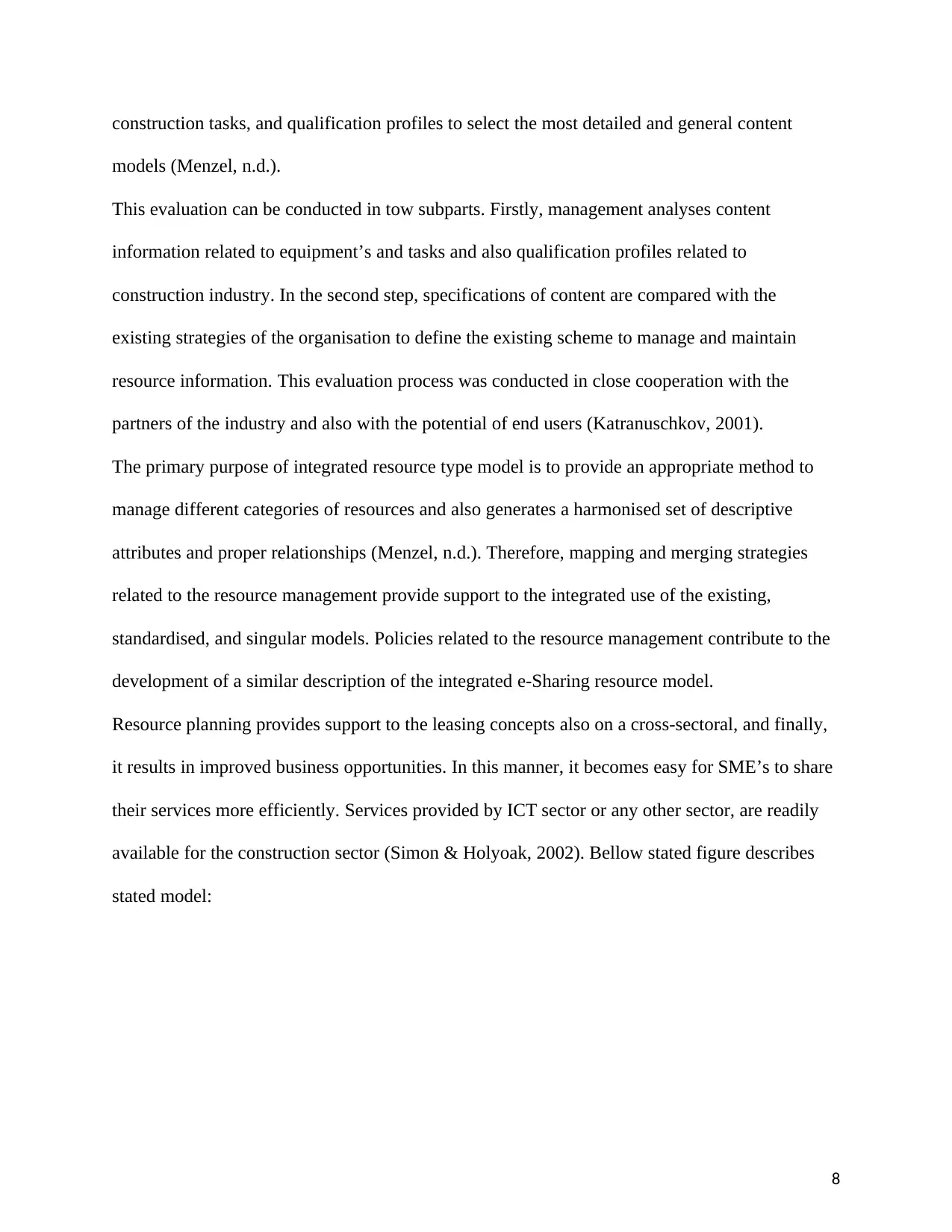
construction tasks, and qualification profiles to select the most detailed and general content
models (Menzel, n.d.).
This evaluation can be conducted in tow subparts. Firstly, management analyses content
information related to equipment’s and tasks and also qualification profiles related to
construction industry. In the second step, specifications of content are compared with the
existing strategies of the organisation to define the existing scheme to manage and maintain
resource information. This evaluation process was conducted in close cooperation with the
partners of the industry and also with the potential of end users (Katranuschkov, 2001).
The primary purpose of integrated resource type model is to provide an appropriate method to
manage different categories of resources and also generates a harmonised set of descriptive
attributes and proper relationships (Menzel, n.d.). Therefore, mapping and merging strategies
related to the resource management provide support to the integrated use of the existing,
standardised, and singular models. Policies related to the resource management contribute to the
development of a similar description of the integrated e-Sharing resource model.
Resource planning provides support to the leasing concepts also on a cross-sectoral, and finally,
it results in improved business opportunities. In this manner, it becomes easy for SME’s to share
their services more efficiently. Services provided by ICT sector or any other sector, are readily
available for the construction sector (Simon & Holyoak, 2002). Bellow stated figure describes
stated model:
8
models (Menzel, n.d.).
This evaluation can be conducted in tow subparts. Firstly, management analyses content
information related to equipment’s and tasks and also qualification profiles related to
construction industry. In the second step, specifications of content are compared with the
existing strategies of the organisation to define the existing scheme to manage and maintain
resource information. This evaluation process was conducted in close cooperation with the
partners of the industry and also with the potential of end users (Katranuschkov, 2001).
The primary purpose of integrated resource type model is to provide an appropriate method to
manage different categories of resources and also generates a harmonised set of descriptive
attributes and proper relationships (Menzel, n.d.). Therefore, mapping and merging strategies
related to the resource management provide support to the integrated use of the existing,
standardised, and singular models. Policies related to the resource management contribute to the
development of a similar description of the integrated e-Sharing resource model.
Resource planning provides support to the leasing concepts also on a cross-sectoral, and finally,
it results in improved business opportunities. In this manner, it becomes easy for SME’s to share
their services more efficiently. Services provided by ICT sector or any other sector, are readily
available for the construction sector (Simon & Holyoak, 2002). Bellow stated figure describes
stated model:
8
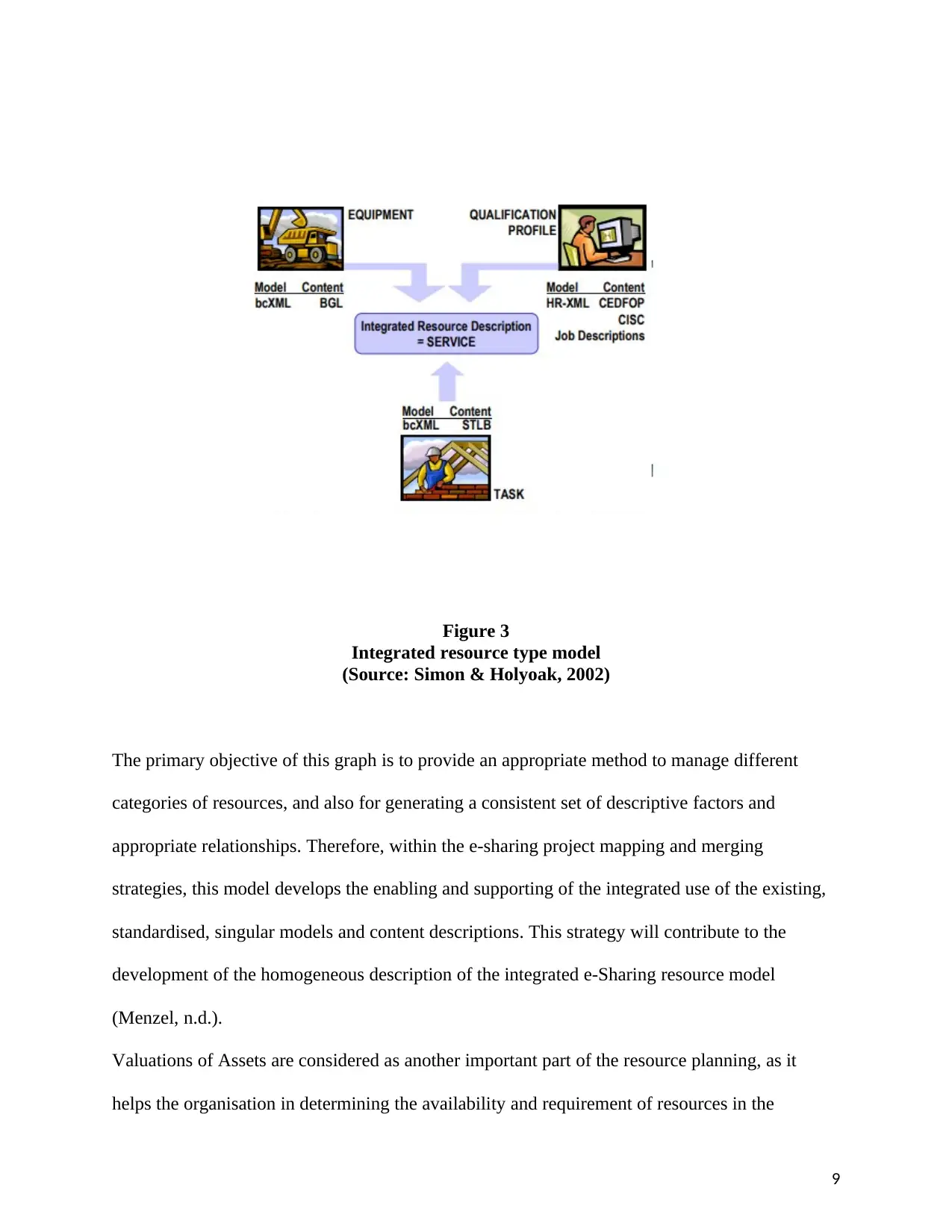
Figure 3
Integrated resource type model
(Source: Simon & Holyoak, 2002)
The primary objective of this graph is to provide an appropriate method to manage different
categories of resources, and also for generating a consistent set of descriptive factors and
appropriate relationships. Therefore, within the e-sharing project mapping and merging
strategies, this model develops the enabling and supporting of the integrated use of the existing,
standardised, singular models and content descriptions. This strategy will contribute to the
development of the homogeneous description of the integrated e-Sharing resource model
(Menzel, n.d.).
Valuations of Assets are considered as another important part of the resource planning, as it
helps the organisation in determining the availability and requirement of resources in the
9
Integrated resource type model
(Source: Simon & Holyoak, 2002)
The primary objective of this graph is to provide an appropriate method to manage different
categories of resources, and also for generating a consistent set of descriptive factors and
appropriate relationships. Therefore, within the e-sharing project mapping and merging
strategies, this model develops the enabling and supporting of the integrated use of the existing,
standardised, singular models and content descriptions. This strategy will contribute to the
development of the homogeneous description of the integrated e-Sharing resource model
(Menzel, n.d.).
Valuations of Assets are considered as another important part of the resource planning, as it
helps the organisation in determining the availability and requirement of resources in the
9
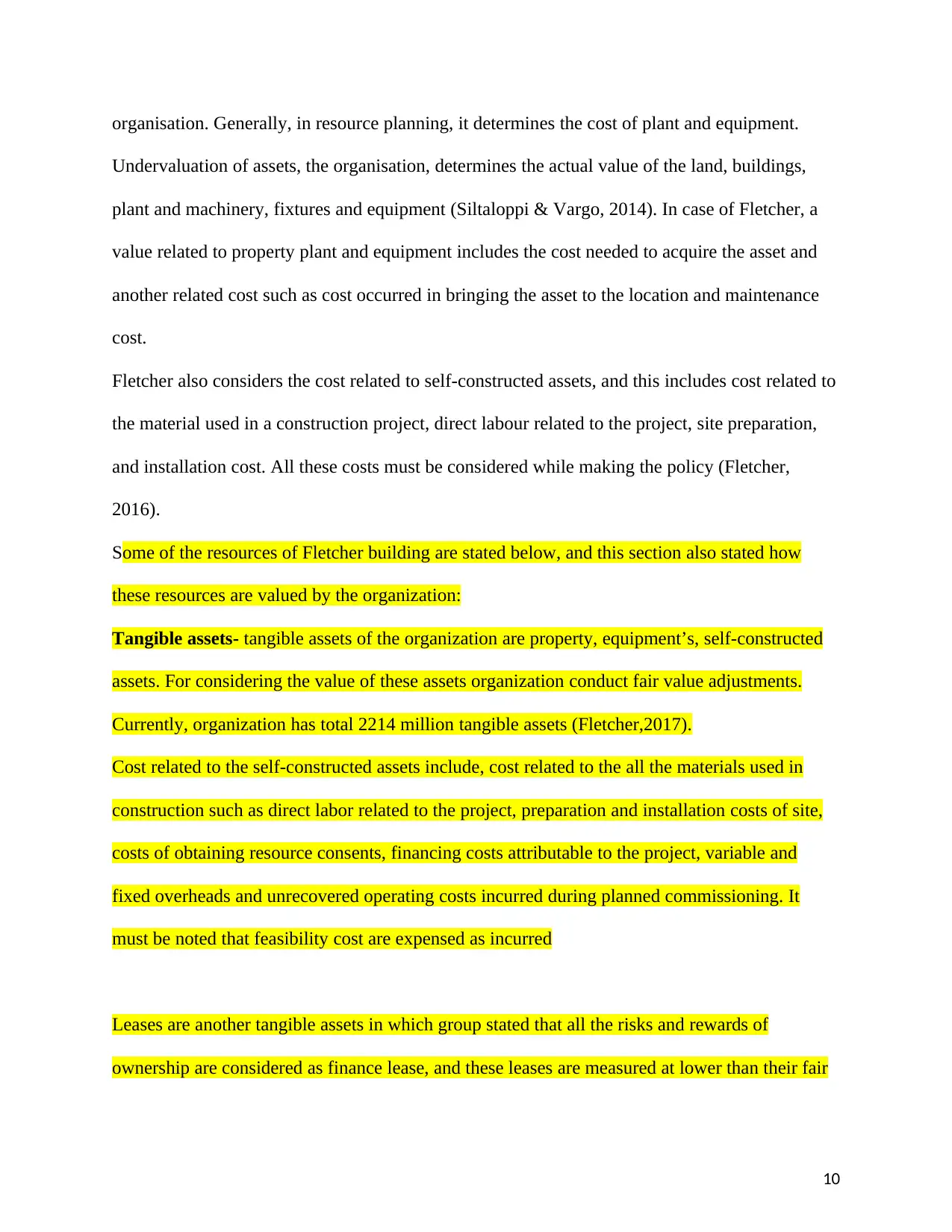
organisation. Generally, in resource planning, it determines the cost of plant and equipment.
Undervaluation of assets, the organisation, determines the actual value of the land, buildings,
plant and machinery, fixtures and equipment (Siltaloppi & Vargo, 2014). In case of Fletcher, a
value related to property plant and equipment includes the cost needed to acquire the asset and
another related cost such as cost occurred in bringing the asset to the location and maintenance
cost.
Fletcher also considers the cost related to self-constructed assets, and this includes cost related to
the material used in a construction project, direct labour related to the project, site preparation,
and installation cost. All these costs must be considered while making the policy (Fletcher,
2016).
Some of the resources of Fletcher building are stated below, and this section also stated how
these resources are valued by the organization:
Tangible assets- tangible assets of the organization are property, equipment’s, self-constructed
assets. For considering the value of these assets organization conduct fair value adjustments.
Currently, organization has total 2214 million tangible assets (Fletcher,2017).
Cost related to the self-constructed assets include, cost related to the all the materials used in
construction such as direct labor related to the project, preparation and installation costs of site,
costs of obtaining resource consents, financing costs attributable to the project, variable and
fixed overheads and unrecovered operating costs incurred during planned commissioning. It
must be noted that feasibility cost are expensed as incurred
Leases are another tangible assets in which group stated that all the risks and rewards of
ownership are considered as finance lease, and these leases are measured at lower than their fair
10
Undervaluation of assets, the organisation, determines the actual value of the land, buildings,
plant and machinery, fixtures and equipment (Siltaloppi & Vargo, 2014). In case of Fletcher, a
value related to property plant and equipment includes the cost needed to acquire the asset and
another related cost such as cost occurred in bringing the asset to the location and maintenance
cost.
Fletcher also considers the cost related to self-constructed assets, and this includes cost related to
the material used in a construction project, direct labour related to the project, site preparation,
and installation cost. All these costs must be considered while making the policy (Fletcher,
2016).
Some of the resources of Fletcher building are stated below, and this section also stated how
these resources are valued by the organization:
Tangible assets- tangible assets of the organization are property, equipment’s, self-constructed
assets. For considering the value of these assets organization conduct fair value adjustments.
Currently, organization has total 2214 million tangible assets (Fletcher,2017).
Cost related to the self-constructed assets include, cost related to the all the materials used in
construction such as direct labor related to the project, preparation and installation costs of site,
costs of obtaining resource consents, financing costs attributable to the project, variable and
fixed overheads and unrecovered operating costs incurred during planned commissioning. It
must be noted that feasibility cost are expensed as incurred
Leases are another tangible assets in which group stated that all the risks and rewards of
ownership are considered as finance lease, and these leases are measured at lower than their fair
10
Secure Best Marks with AI Grader
Need help grading? Try our AI Grader for instant feedback on your assignments.
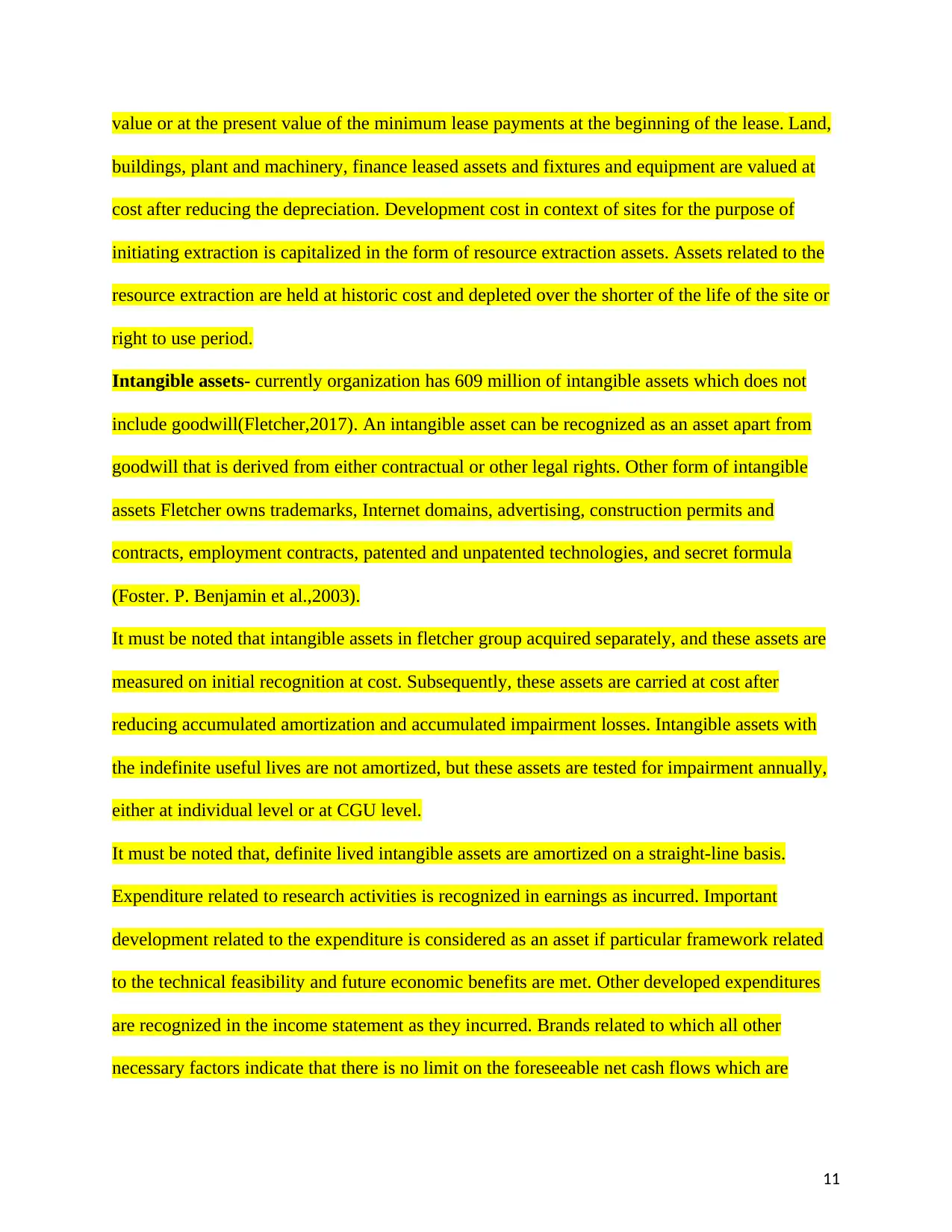
value or at the present value of the minimum lease payments at the beginning of the lease. Land,
buildings, plant and machinery, finance leased assets and fixtures and equipment are valued at
cost after reducing the depreciation. Development cost in context of sites for the purpose of
initiating extraction is capitalized in the form of resource extraction assets. Assets related to the
resource extraction are held at historic cost and depleted over the shorter of the life of the site or
right to use period.
Intangible assets- currently organization has 609 million of intangible assets which does not
include goodwill(Fletcher,2017). An intangible asset can be recognized as an asset apart from
goodwill that is derived from either contractual or other legal rights. Other form of intangible
assets Fletcher owns trademarks, Internet domains, advertising, construction permits and
contracts, employment contracts, patented and unpatented technologies, and secret formula
(Foster. P. Benjamin et al.,2003).
It must be noted that intangible assets in fletcher group acquired separately, and these assets are
measured on initial recognition at cost. Subsequently, these assets are carried at cost after
reducing accumulated amortization and accumulated impairment losses. Intangible assets with
the indefinite useful lives are not amortized, but these assets are tested for impairment annually,
either at individual level or at CGU level.
It must be noted that, definite lived intangible assets are amortized on a straight-line basis.
Expenditure related to research activities is recognized in earnings as incurred. Important
development related to the expenditure is considered as an asset if particular framework related
to the technical feasibility and future economic benefits are met. Other developed expenditures
are recognized in the income statement as they incurred. Brands related to which all other
necessary factors indicate that there is no limit on the foreseeable net cash flows which are
11
buildings, plant and machinery, finance leased assets and fixtures and equipment are valued at
cost after reducing the depreciation. Development cost in context of sites for the purpose of
initiating extraction is capitalized in the form of resource extraction assets. Assets related to the
resource extraction are held at historic cost and depleted over the shorter of the life of the site or
right to use period.
Intangible assets- currently organization has 609 million of intangible assets which does not
include goodwill(Fletcher,2017). An intangible asset can be recognized as an asset apart from
goodwill that is derived from either contractual or other legal rights. Other form of intangible
assets Fletcher owns trademarks, Internet domains, advertising, construction permits and
contracts, employment contracts, patented and unpatented technologies, and secret formula
(Foster. P. Benjamin et al.,2003).
It must be noted that intangible assets in fletcher group acquired separately, and these assets are
measured on initial recognition at cost. Subsequently, these assets are carried at cost after
reducing accumulated amortization and accumulated impairment losses. Intangible assets with
the indefinite useful lives are not amortized, but these assets are tested for impairment annually,
either at individual level or at CGU level.
It must be noted that, definite lived intangible assets are amortized on a straight-line basis.
Expenditure related to research activities is recognized in earnings as incurred. Important
development related to the expenditure is considered as an asset if particular framework related
to the technical feasibility and future economic benefits are met. Other developed expenditures
are recognized in the income statement as they incurred. Brands related to which all other
necessary factors indicate that there is no limit on the foreseeable net cash flows which are
11
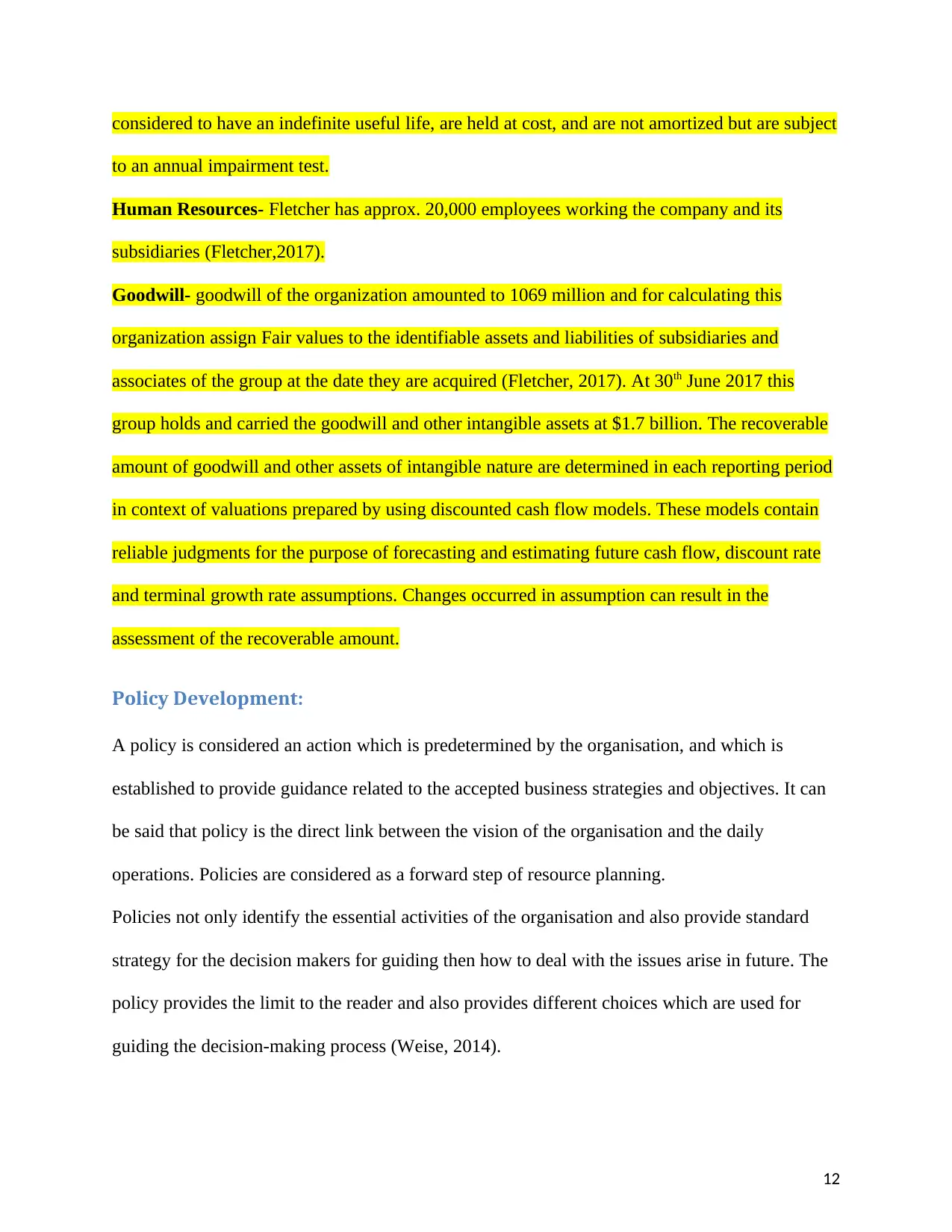
considered to have an indefinite useful life, are held at cost, and are not amortized but are subject
to an annual impairment test.
Human Resources- Fletcher has approx. 20,000 employees working the company and its
subsidiaries (Fletcher,2017).
Goodwill- goodwill of the organization amounted to 1069 million and for calculating this
organization assign Fair values to the identifiable assets and liabilities of subsidiaries and
associates of the group at the date they are acquired (Fletcher, 2017). At 30th June 2017 this
group holds and carried the goodwill and other intangible assets at $1.7 billion. The recoverable
amount of goodwill and other assets of intangible nature are determined in each reporting period
in context of valuations prepared by using discounted cash flow models. These models contain
reliable judgments for the purpose of forecasting and estimating future cash flow, discount rate
and terminal growth rate assumptions. Changes occurred in assumption can result in the
assessment of the recoverable amount.
Policy Development:
A policy is considered an action which is predetermined by the organisation, and which is
established to provide guidance related to the accepted business strategies and objectives. It can
be said that policy is the direct link between the vision of the organisation and the daily
operations. Policies are considered as a forward step of resource planning.
Policies not only identify the essential activities of the organisation and also provide standard
strategy for the decision makers for guiding then how to deal with the issues arise in future. The
policy provides the limit to the reader and also provides different choices which are used for
guiding the decision-making process (Weise, 2014).
12
to an annual impairment test.
Human Resources- Fletcher has approx. 20,000 employees working the company and its
subsidiaries (Fletcher,2017).
Goodwill- goodwill of the organization amounted to 1069 million and for calculating this
organization assign Fair values to the identifiable assets and liabilities of subsidiaries and
associates of the group at the date they are acquired (Fletcher, 2017). At 30th June 2017 this
group holds and carried the goodwill and other intangible assets at $1.7 billion. The recoverable
amount of goodwill and other assets of intangible nature are determined in each reporting period
in context of valuations prepared by using discounted cash flow models. These models contain
reliable judgments for the purpose of forecasting and estimating future cash flow, discount rate
and terminal growth rate assumptions. Changes occurred in assumption can result in the
assessment of the recoverable amount.
Policy Development:
A policy is considered an action which is predetermined by the organisation, and which is
established to provide guidance related to the accepted business strategies and objectives. It can
be said that policy is the direct link between the vision of the organisation and the daily
operations. Policies are considered as a forward step of resource planning.
Policies not only identify the essential activities of the organisation and also provide standard
strategy for the decision makers for guiding then how to deal with the issues arise in future. The
policy provides the limit to the reader and also provides different choices which are used for
guiding the decision-making process (Weise, 2014).
12
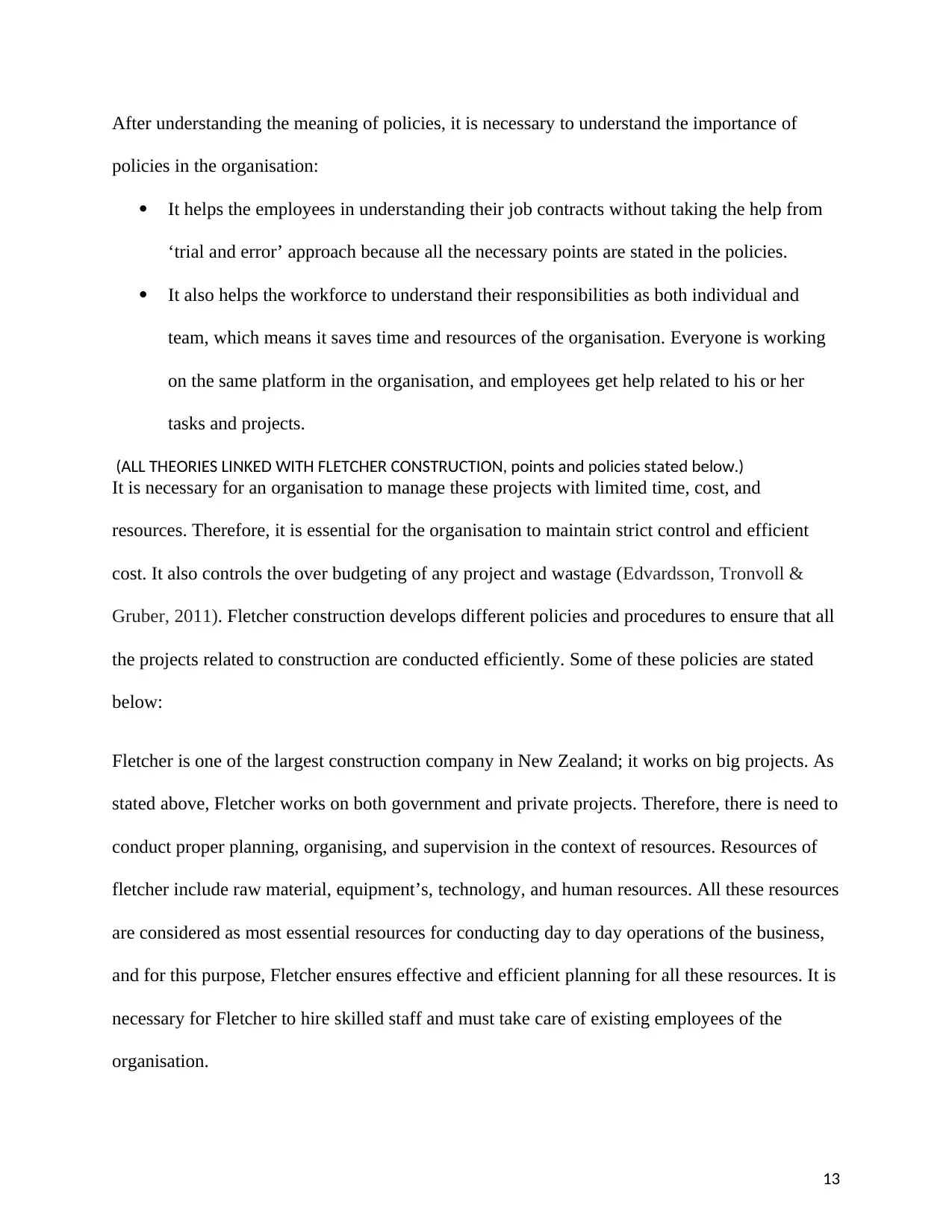
After understanding the meaning of policies, it is necessary to understand the importance of
policies in the organisation:
It helps the employees in understanding their job contracts without taking the help from
‘trial and error’ approach because all the necessary points are stated in the policies.
It also helps the workforce to understand their responsibilities as both individual and
team, which means it saves time and resources of the organisation. Everyone is working
on the same platform in the organisation, and employees get help related to his or her
tasks and projects.
(ALL THEORIES LINKED WITH FLETCHER CONSTRUCTION, points and policies stated below.)
It is necessary for an organisation to manage these projects with limited time, cost, and
resources. Therefore, it is essential for the organisation to maintain strict control and efficient
cost. It also controls the over budgeting of any project and wastage (Edvardsson, Tronvoll &
Gruber, 2011). Fletcher construction develops different policies and procedures to ensure that all
the projects related to construction are conducted efficiently. Some of these policies are stated
below:
Fletcher is one of the largest construction company in New Zealand; it works on big projects. As
stated above, Fletcher works on both government and private projects. Therefore, there is need to
conduct proper planning, organising, and supervision in the context of resources. Resources of
fletcher include raw material, equipment’s, technology, and human resources. All these resources
are considered as most essential resources for conducting day to day operations of the business,
and for this purpose, Fletcher ensures effective and efficient planning for all these resources. It is
necessary for Fletcher to hire skilled staff and must take care of existing employees of the
organisation.
13
policies in the organisation:
It helps the employees in understanding their job contracts without taking the help from
‘trial and error’ approach because all the necessary points are stated in the policies.
It also helps the workforce to understand their responsibilities as both individual and
team, which means it saves time and resources of the organisation. Everyone is working
on the same platform in the organisation, and employees get help related to his or her
tasks and projects.
(ALL THEORIES LINKED WITH FLETCHER CONSTRUCTION, points and policies stated below.)
It is necessary for an organisation to manage these projects with limited time, cost, and
resources. Therefore, it is essential for the organisation to maintain strict control and efficient
cost. It also controls the over budgeting of any project and wastage (Edvardsson, Tronvoll &
Gruber, 2011). Fletcher construction develops different policies and procedures to ensure that all
the projects related to construction are conducted efficiently. Some of these policies are stated
below:
Fletcher is one of the largest construction company in New Zealand; it works on big projects. As
stated above, Fletcher works on both government and private projects. Therefore, there is need to
conduct proper planning, organising, and supervision in the context of resources. Resources of
fletcher include raw material, equipment’s, technology, and human resources. All these resources
are considered as most essential resources for conducting day to day operations of the business,
and for this purpose, Fletcher ensures effective and efficient planning for all these resources. It is
necessary for Fletcher to hire skilled staff and must take care of existing employees of the
organisation.
13
Paraphrase This Document
Need a fresh take? Get an instant paraphrase of this document with our AI Paraphraser
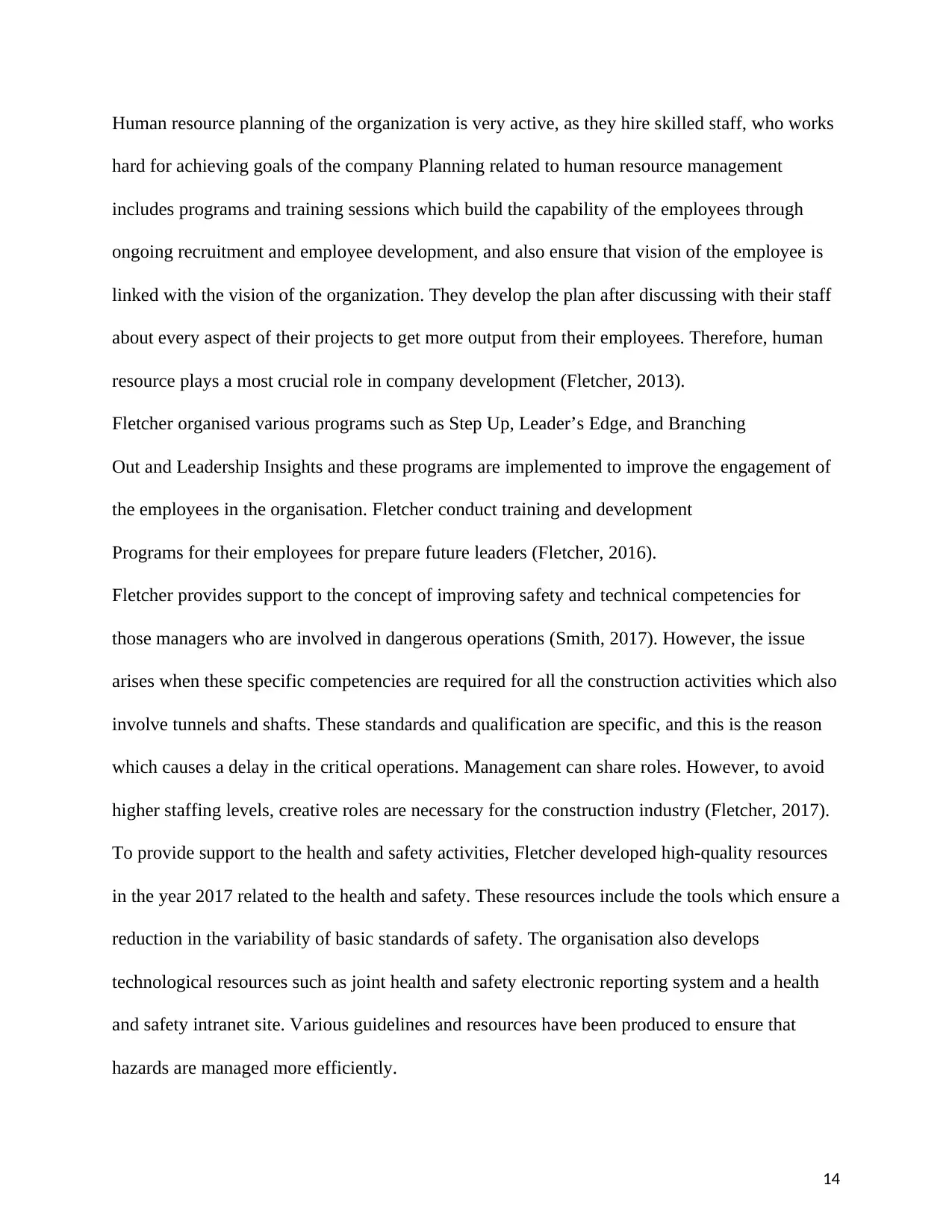
Human resource planning of the organization is very active, as they hire skilled staff, who works
hard for achieving goals of the company Planning related to human resource management
includes programs and training sessions which build the capability of the employees through
ongoing recruitment and employee development, and also ensure that vision of the employee is
linked with the vision of the organization. They develop the plan after discussing with their staff
about every aspect of their projects to get more output from their employees. Therefore, human
resource plays a most crucial role in company development (Fletcher, 2013).
Fletcher organised various programs such as Step Up, Leader’s Edge, and Branching
Out and Leadership Insights and these programs are implemented to improve the engagement of
the employees in the organisation. Fletcher conduct training and development
Programs for their employees for prepare future leaders (Fletcher, 2016).
Fletcher provides support to the concept of improving safety and technical competencies for
those managers who are involved in dangerous operations (Smith, 2017). However, the issue
arises when these specific competencies are required for all the construction activities which also
involve tunnels and shafts. These standards and qualification are specific, and this is the reason
which causes a delay in the critical operations. Management can share roles. However, to avoid
higher staffing levels, creative roles are necessary for the construction industry (Fletcher, 2017).
To provide support to the health and safety activities, Fletcher developed high-quality resources
in the year 2017 related to the health and safety. These resources include the tools which ensure a
reduction in the variability of basic standards of safety. The organisation also develops
technological resources such as joint health and safety electronic reporting system and a health
and safety intranet site. Various guidelines and resources have been produced to ensure that
hazards are managed more efficiently.
14
hard for achieving goals of the company Planning related to human resource management
includes programs and training sessions which build the capability of the employees through
ongoing recruitment and employee development, and also ensure that vision of the employee is
linked with the vision of the organization. They develop the plan after discussing with their staff
about every aspect of their projects to get more output from their employees. Therefore, human
resource plays a most crucial role in company development (Fletcher, 2013).
Fletcher organised various programs such as Step Up, Leader’s Edge, and Branching
Out and Leadership Insights and these programs are implemented to improve the engagement of
the employees in the organisation. Fletcher conduct training and development
Programs for their employees for prepare future leaders (Fletcher, 2016).
Fletcher provides support to the concept of improving safety and technical competencies for
those managers who are involved in dangerous operations (Smith, 2017). However, the issue
arises when these specific competencies are required for all the construction activities which also
involve tunnels and shafts. These standards and qualification are specific, and this is the reason
which causes a delay in the critical operations. Management can share roles. However, to avoid
higher staffing levels, creative roles are necessary for the construction industry (Fletcher, 2017).
To provide support to the health and safety activities, Fletcher developed high-quality resources
in the year 2017 related to the health and safety. These resources include the tools which ensure a
reduction in the variability of basic standards of safety. The organisation also develops
technological resources such as joint health and safety electronic reporting system and a health
and safety intranet site. Various guidelines and resources have been produced to ensure that
hazards are managed more efficiently.
14
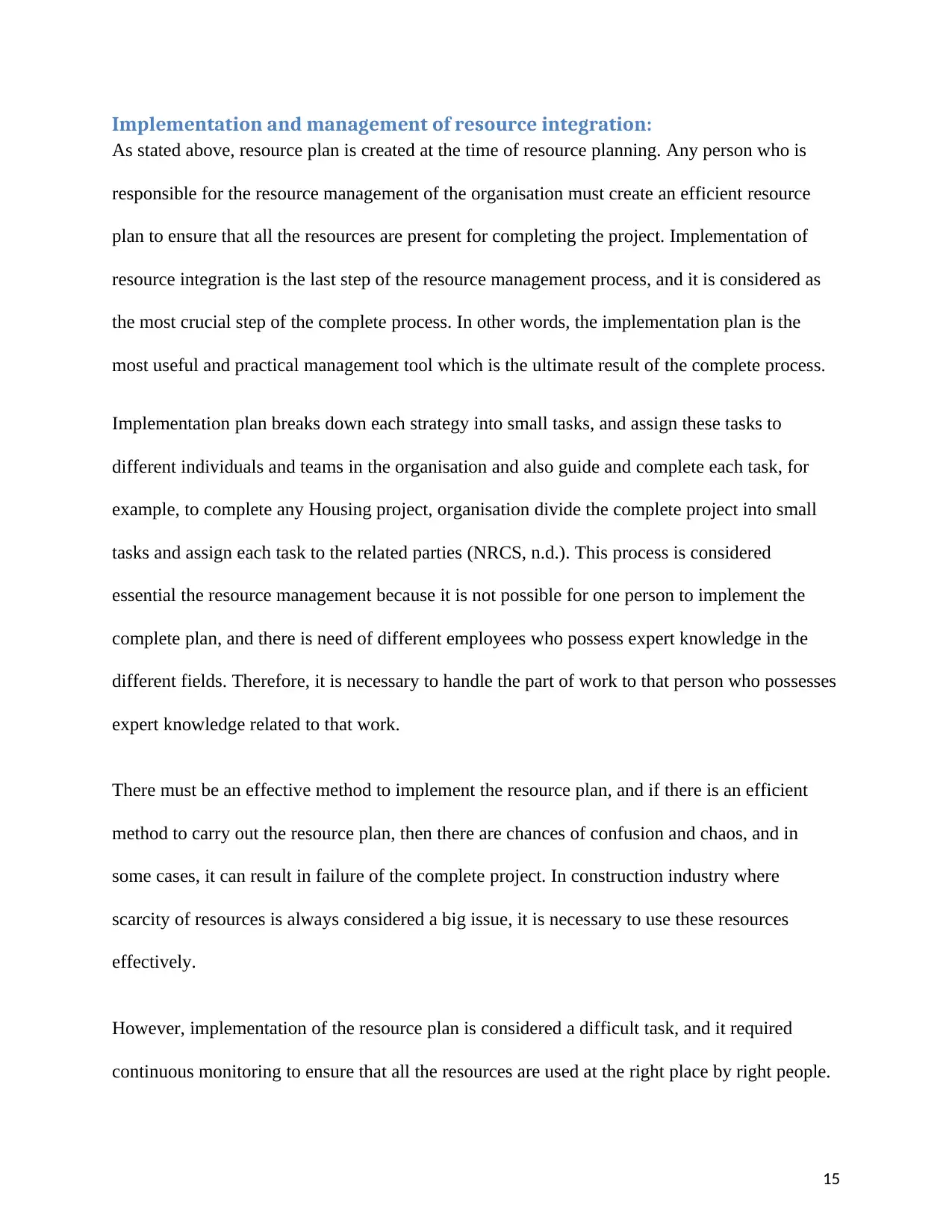
Implementation and management of resource integration:
As stated above, resource plan is created at the time of resource planning. Any person who is
responsible for the resource management of the organisation must create an efficient resource
plan to ensure that all the resources are present for completing the project. Implementation of
resource integration is the last step of the resource management process, and it is considered as
the most crucial step of the complete process. In other words, the implementation plan is the
most useful and practical management tool which is the ultimate result of the complete process.
Implementation plan breaks down each strategy into small tasks, and assign these tasks to
different individuals and teams in the organisation and also guide and complete each task, for
example, to complete any Housing project, organisation divide the complete project into small
tasks and assign each task to the related parties (NRCS, n.d.). This process is considered
essential the resource management because it is not possible for one person to implement the
complete plan, and there is need of different employees who possess expert knowledge in the
different fields. Therefore, it is necessary to handle the part of work to that person who possesses
expert knowledge related to that work.
There must be an effective method to implement the resource plan, and if there is an efficient
method to carry out the resource plan, then there are chances of confusion and chaos, and in
some cases, it can result in failure of the complete project. In construction industry where
scarcity of resources is always considered a big issue, it is necessary to use these resources
effectively.
However, implementation of the resource plan is considered a difficult task, and it required
continuous monitoring to ensure that all the resources are used at the right place by right people.
15
As stated above, resource plan is created at the time of resource planning. Any person who is
responsible for the resource management of the organisation must create an efficient resource
plan to ensure that all the resources are present for completing the project. Implementation of
resource integration is the last step of the resource management process, and it is considered as
the most crucial step of the complete process. In other words, the implementation plan is the
most useful and practical management tool which is the ultimate result of the complete process.
Implementation plan breaks down each strategy into small tasks, and assign these tasks to
different individuals and teams in the organisation and also guide and complete each task, for
example, to complete any Housing project, organisation divide the complete project into small
tasks and assign each task to the related parties (NRCS, n.d.). This process is considered
essential the resource management because it is not possible for one person to implement the
complete plan, and there is need of different employees who possess expert knowledge in the
different fields. Therefore, it is necessary to handle the part of work to that person who possesses
expert knowledge related to that work.
There must be an effective method to implement the resource plan, and if there is an efficient
method to carry out the resource plan, then there are chances of confusion and chaos, and in
some cases, it can result in failure of the complete project. In construction industry where
scarcity of resources is always considered a big issue, it is necessary to use these resources
effectively.
However, implementation of the resource plan is considered a difficult task, and it required
continuous monitoring to ensure that all the resources are used at the right place by right people.
15
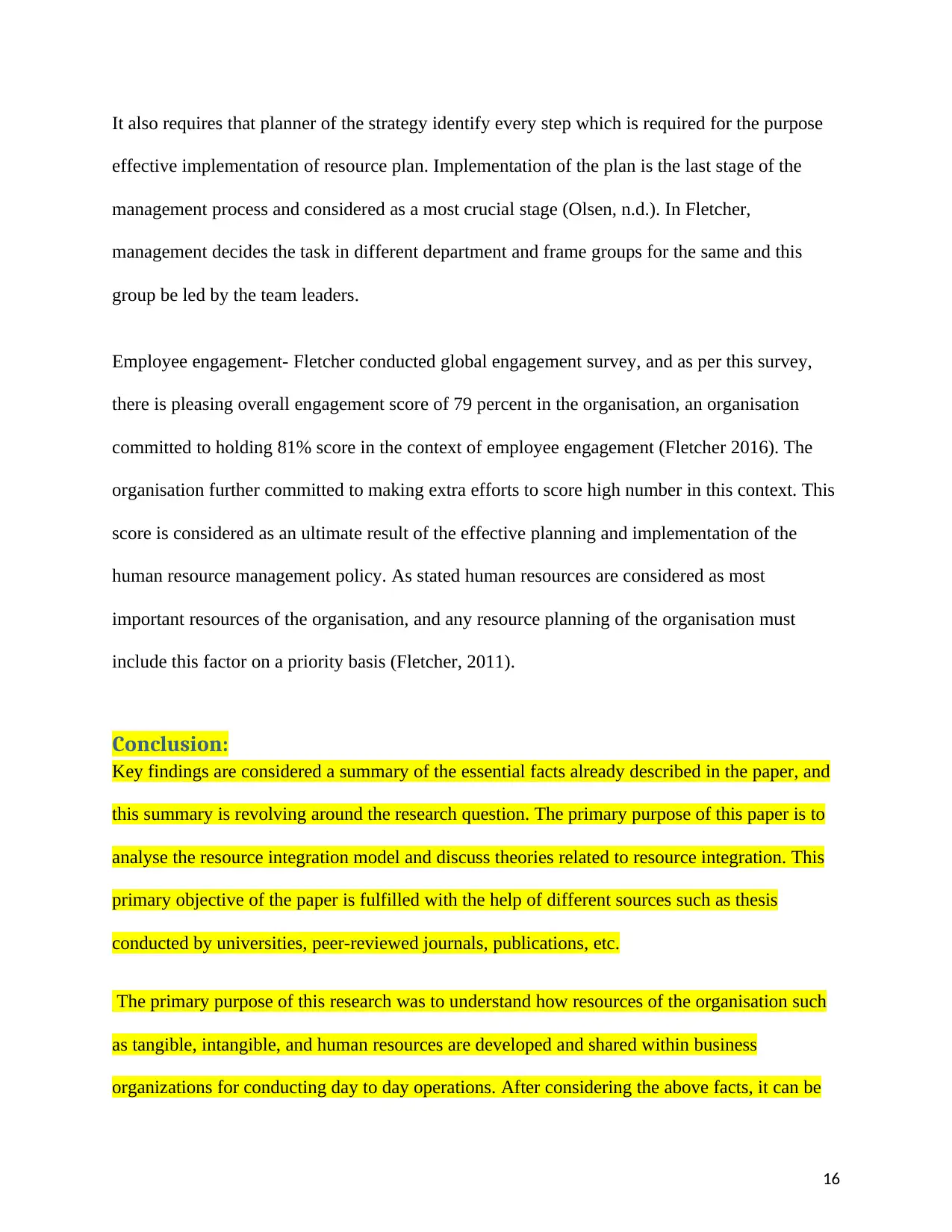
It also requires that planner of the strategy identify every step which is required for the purpose
effective implementation of resource plan. Implementation of the plan is the last stage of the
management process and considered as a most crucial stage (Olsen, n.d.). In Fletcher,
management decides the task in different department and frame groups for the same and this
group be led by the team leaders.
Employee engagement- Fletcher conducted global engagement survey, and as per this survey,
there is pleasing overall engagement score of 79 percent in the organisation, an organisation
committed to holding 81% score in the context of employee engagement (Fletcher 2016). The
organisation further committed to making extra efforts to score high number in this context. This
score is considered as an ultimate result of the effective planning and implementation of the
human resource management policy. As stated human resources are considered as most
important resources of the organisation, and any resource planning of the organisation must
include this factor on a priority basis (Fletcher, 2011).
Conclusion:
Key findings are considered a summary of the essential facts already described in the paper, and
this summary is revolving around the research question. The primary purpose of this paper is to
analyse the resource integration model and discuss theories related to resource integration. This
primary objective of the paper is fulfilled with the help of different sources such as thesis
conducted by universities, peer-reviewed journals, publications, etc.
The primary purpose of this research was to understand how resources of the organisation such
as tangible, intangible, and human resources are developed and shared within business
organizations for conducting day to day operations. After considering the above facts, it can be
16
effective implementation of resource plan. Implementation of the plan is the last stage of the
management process and considered as a most crucial stage (Olsen, n.d.). In Fletcher,
management decides the task in different department and frame groups for the same and this
group be led by the team leaders.
Employee engagement- Fletcher conducted global engagement survey, and as per this survey,
there is pleasing overall engagement score of 79 percent in the organisation, an organisation
committed to holding 81% score in the context of employee engagement (Fletcher 2016). The
organisation further committed to making extra efforts to score high number in this context. This
score is considered as an ultimate result of the effective planning and implementation of the
human resource management policy. As stated human resources are considered as most
important resources of the organisation, and any resource planning of the organisation must
include this factor on a priority basis (Fletcher, 2011).
Conclusion:
Key findings are considered a summary of the essential facts already described in the paper, and
this summary is revolving around the research question. The primary purpose of this paper is to
analyse the resource integration model and discuss theories related to resource integration. This
primary objective of the paper is fulfilled with the help of different sources such as thesis
conducted by universities, peer-reviewed journals, publications, etc.
The primary purpose of this research was to understand how resources of the organisation such
as tangible, intangible, and human resources are developed and shared within business
organizations for conducting day to day operations. After considering the above facts, it can be
16
Secure Best Marks with AI Grader
Need help grading? Try our AI Grader for instant feedback on your assignments.
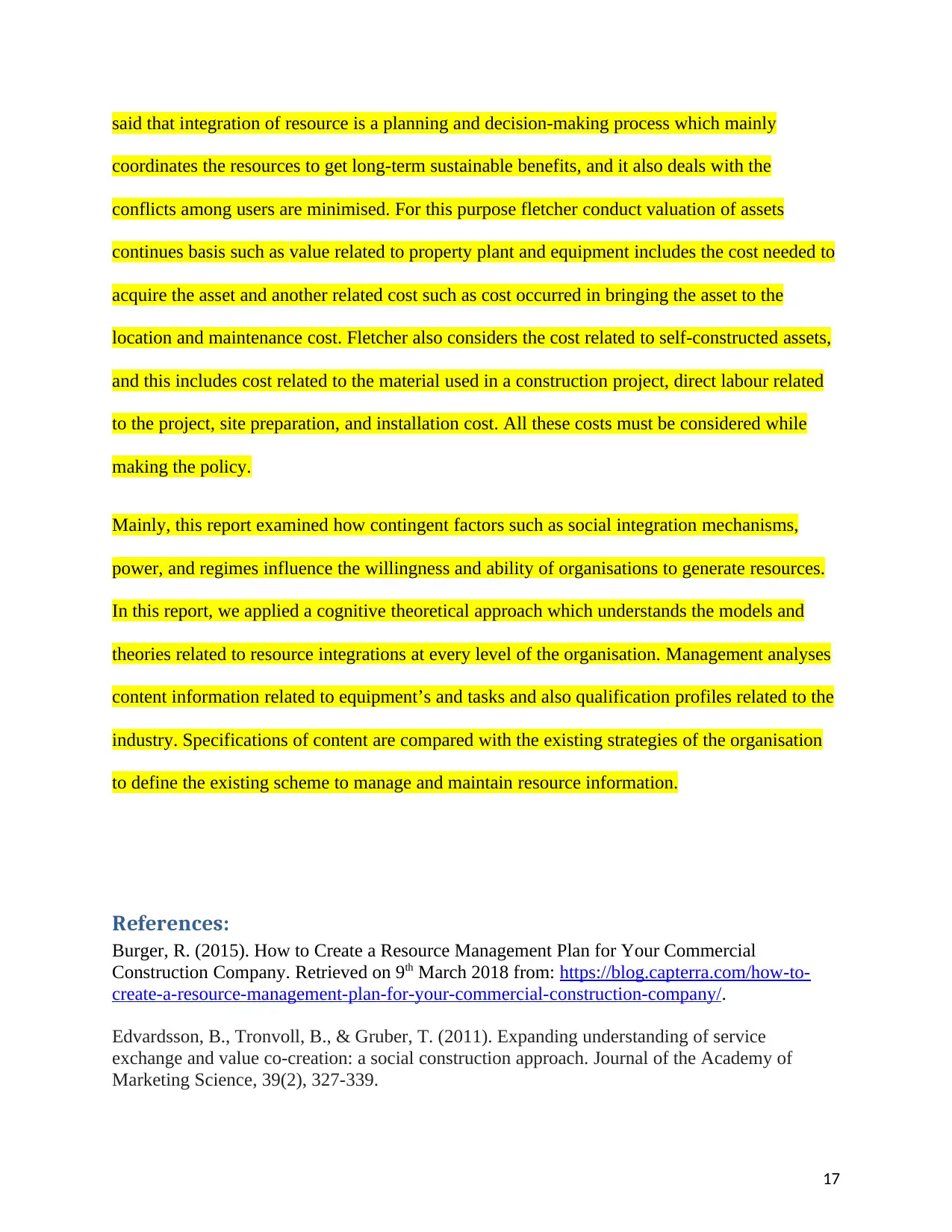
said that integration of resource is a planning and decision-making process which mainly
coordinates the resources to get long-term sustainable benefits, and it also deals with the
conflicts among users are minimised. For this purpose fletcher conduct valuation of assets
continues basis such as value related to property plant and equipment includes the cost needed to
acquire the asset and another related cost such as cost occurred in bringing the asset to the
location and maintenance cost. Fletcher also considers the cost related to self-constructed assets,
and this includes cost related to the material used in a construction project, direct labour related
to the project, site preparation, and installation cost. All these costs must be considered while
making the policy.
Mainly, this report examined how contingent factors such as social integration mechanisms,
power, and regimes influence the willingness and ability of organisations to generate resources.
In this report, we applied a cognitive theoretical approach which understands the models and
theories related to resource integrations at every level of the organisation. Management analyses
content information related to equipment’s and tasks and also qualification profiles related to the
industry. Specifications of content are compared with the existing strategies of the organisation
to define the existing scheme to manage and maintain resource information.
References:
Burger, R. (2015). How to Create a Resource Management Plan for Your Commercial
Construction Company. Retrieved on 9th March 2018 from: https://blog.capterra.com/how-to-
create-a-resource-management-plan-for-your-commercial-construction-company/.
Edvardsson, B., Tronvoll, B., & Gruber, T. (2011). Expanding understanding of service
exchange and value co-creation: a social construction approach. Journal of the Academy of
Marketing Science, 39(2), 327-339.
17
coordinates the resources to get long-term sustainable benefits, and it also deals with the
conflicts among users are minimised. For this purpose fletcher conduct valuation of assets
continues basis such as value related to property plant and equipment includes the cost needed to
acquire the asset and another related cost such as cost occurred in bringing the asset to the
location and maintenance cost. Fletcher also considers the cost related to self-constructed assets,
and this includes cost related to the material used in a construction project, direct labour related
to the project, site preparation, and installation cost. All these costs must be considered while
making the policy.
Mainly, this report examined how contingent factors such as social integration mechanisms,
power, and regimes influence the willingness and ability of organisations to generate resources.
In this report, we applied a cognitive theoretical approach which understands the models and
theories related to resource integrations at every level of the organisation. Management analyses
content information related to equipment’s and tasks and also qualification profiles related to the
industry. Specifications of content are compared with the existing strategies of the organisation
to define the existing scheme to manage and maintain resource information.
References:
Burger, R. (2015). How to Create a Resource Management Plan for Your Commercial
Construction Company. Retrieved on 9th March 2018 from: https://blog.capterra.com/how-to-
create-a-resource-management-plan-for-your-commercial-construction-company/.
Edvardsson, B., Tronvoll, B., & Gruber, T. (2011). Expanding understanding of service
exchange and value co-creation: a social construction approach. Journal of the Academy of
Marketing Science, 39(2), 327-339.
17
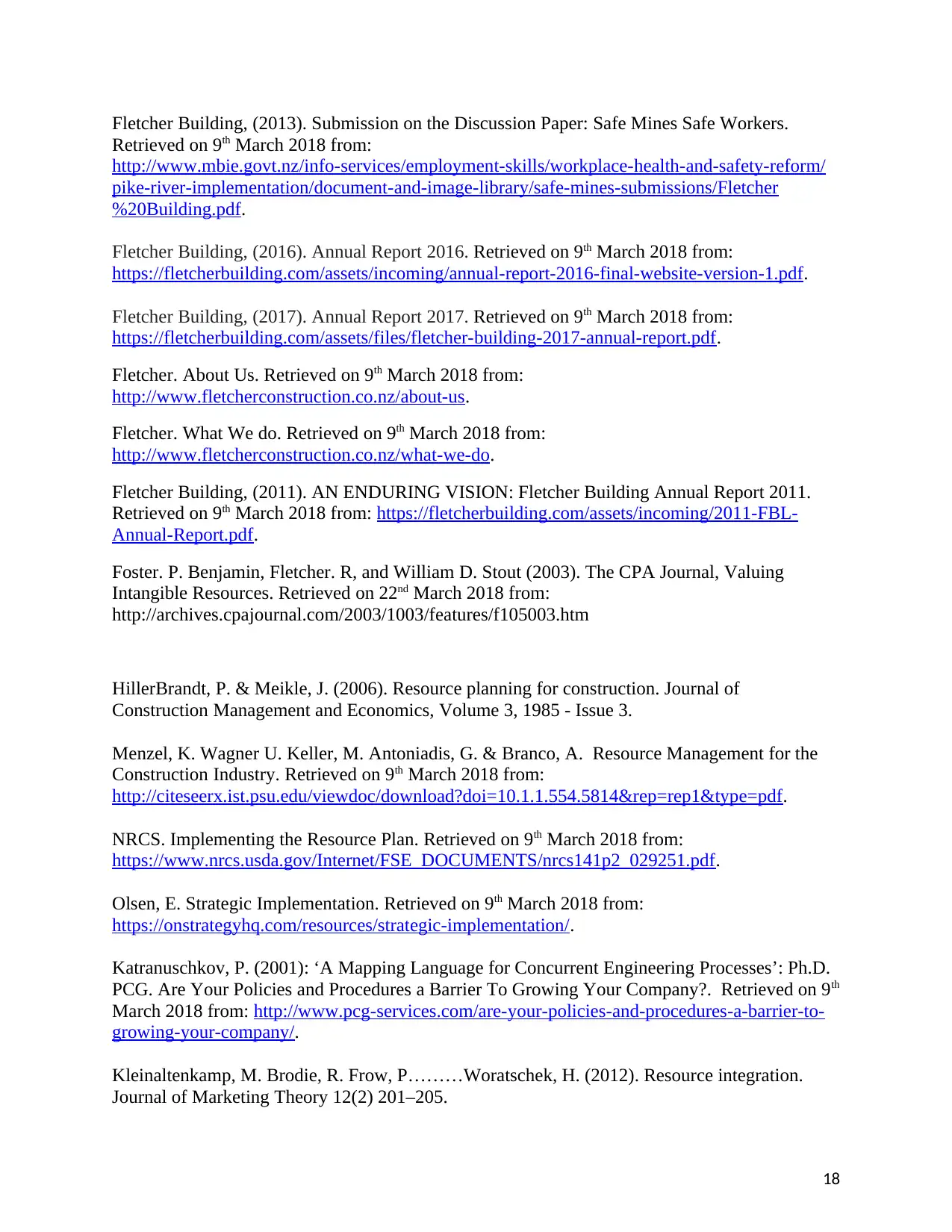
Fletcher Building, (2013). Submission on the Discussion Paper: Safe Mines Safe Workers.
Retrieved on 9th March 2018 from:
http://www.mbie.govt.nz/info-services/employment-skills/workplace-health-and-safety-reform/
pike-river-implementation/document-and-image-library/safe-mines-submissions/Fletcher
%20Building.pdf.
Fletcher Building, (2016). Annual Report 2016. Retrieved on 9th March 2018 from:
https://fletcherbuilding.com/assets/incoming/annual-report-2016-final-website-version-1.pdf.
Fletcher Building, (2017). Annual Report 2017. Retrieved on 9th March 2018 from:
https://fletcherbuilding.com/assets/files/fletcher-building-2017-annual-report.pdf.
Fletcher. About Us. Retrieved on 9th March 2018 from:
http://www.fletcherconstruction.co.nz/about-us.
Fletcher. What We do. Retrieved on 9th March 2018 from:
http://www.fletcherconstruction.co.nz/what-we-do.
Fletcher Building, (2011). AN ENDURING VISION: Fletcher Building Annual Report 2011.
Retrieved on 9th March 2018 from: https://fletcherbuilding.com/assets/incoming/2011-FBL-
Annual-Report.pdf.
Foster. P. Benjamin, Fletcher. R, and William D. Stout (2003). The CPA Journal, Valuing
Intangible Resources. Retrieved on 22nd March 2018 from:
http://archives.cpajournal.com/2003/1003/features/f105003.htm
HillerBrandt, P. & Meikle, J. (2006). Resource planning for construction. Journal of
Construction Management and Economics, Volume 3, 1985 - Issue 3.
Menzel, K. Wagner U. Keller, M. Antoniadis, G. & Branco, A. Resource Management for the
Construction Industry. Retrieved on 9th March 2018 from:
http://citeseerx.ist.psu.edu/viewdoc/download?doi=10.1.1.554.5814&rep=rep1&type=pdf.
NRCS. Implementing the Resource Plan. Retrieved on 9th March 2018 from:
https://www.nrcs.usda.gov/Internet/FSE_DOCUMENTS/nrcs141p2_029251.pdf.
Olsen, E. Strategic Implementation. Retrieved on 9th March 2018 from:
https://onstrategyhq.com/resources/strategic-implementation/.
Katranuschkov, P. (2001): ‘A Mapping Language for Concurrent Engineering Processes’: Ph.D.
PCG. Are Your Policies and Procedures a Barrier To Growing Your Company?. Retrieved on 9th
March 2018 from: http://www.pcg-services.com/are-your-policies-and-procedures-a-barrier-to-
growing-your-company/.
Kleinaltenkamp, M. Brodie, R. Frow, P………Woratschek, H. (2012). Resource integration.
Journal of Marketing Theory 12(2) 201–205.
18
Retrieved on 9th March 2018 from:
http://www.mbie.govt.nz/info-services/employment-skills/workplace-health-and-safety-reform/
pike-river-implementation/document-and-image-library/safe-mines-submissions/Fletcher
%20Building.pdf.
Fletcher Building, (2016). Annual Report 2016. Retrieved on 9th March 2018 from:
https://fletcherbuilding.com/assets/incoming/annual-report-2016-final-website-version-1.pdf.
Fletcher Building, (2017). Annual Report 2017. Retrieved on 9th March 2018 from:
https://fletcherbuilding.com/assets/files/fletcher-building-2017-annual-report.pdf.
Fletcher. About Us. Retrieved on 9th March 2018 from:
http://www.fletcherconstruction.co.nz/about-us.
Fletcher. What We do. Retrieved on 9th March 2018 from:
http://www.fletcherconstruction.co.nz/what-we-do.
Fletcher Building, (2011). AN ENDURING VISION: Fletcher Building Annual Report 2011.
Retrieved on 9th March 2018 from: https://fletcherbuilding.com/assets/incoming/2011-FBL-
Annual-Report.pdf.
Foster. P. Benjamin, Fletcher. R, and William D. Stout (2003). The CPA Journal, Valuing
Intangible Resources. Retrieved on 22nd March 2018 from:
http://archives.cpajournal.com/2003/1003/features/f105003.htm
HillerBrandt, P. & Meikle, J. (2006). Resource planning for construction. Journal of
Construction Management and Economics, Volume 3, 1985 - Issue 3.
Menzel, K. Wagner U. Keller, M. Antoniadis, G. & Branco, A. Resource Management for the
Construction Industry. Retrieved on 9th March 2018 from:
http://citeseerx.ist.psu.edu/viewdoc/download?doi=10.1.1.554.5814&rep=rep1&type=pdf.
NRCS. Implementing the Resource Plan. Retrieved on 9th March 2018 from:
https://www.nrcs.usda.gov/Internet/FSE_DOCUMENTS/nrcs141p2_029251.pdf.
Olsen, E. Strategic Implementation. Retrieved on 9th March 2018 from:
https://onstrategyhq.com/resources/strategic-implementation/.
Katranuschkov, P. (2001): ‘A Mapping Language for Concurrent Engineering Processes’: Ph.D.
PCG. Are Your Policies and Procedures a Barrier To Growing Your Company?. Retrieved on 9th
March 2018 from: http://www.pcg-services.com/are-your-policies-and-procedures-a-barrier-to-
growing-your-company/.
Kleinaltenkamp, M. Brodie, R. Frow, P………Woratschek, H. (2012). Resource integration.
Journal of Marketing Theory 12(2) 201–205.
18
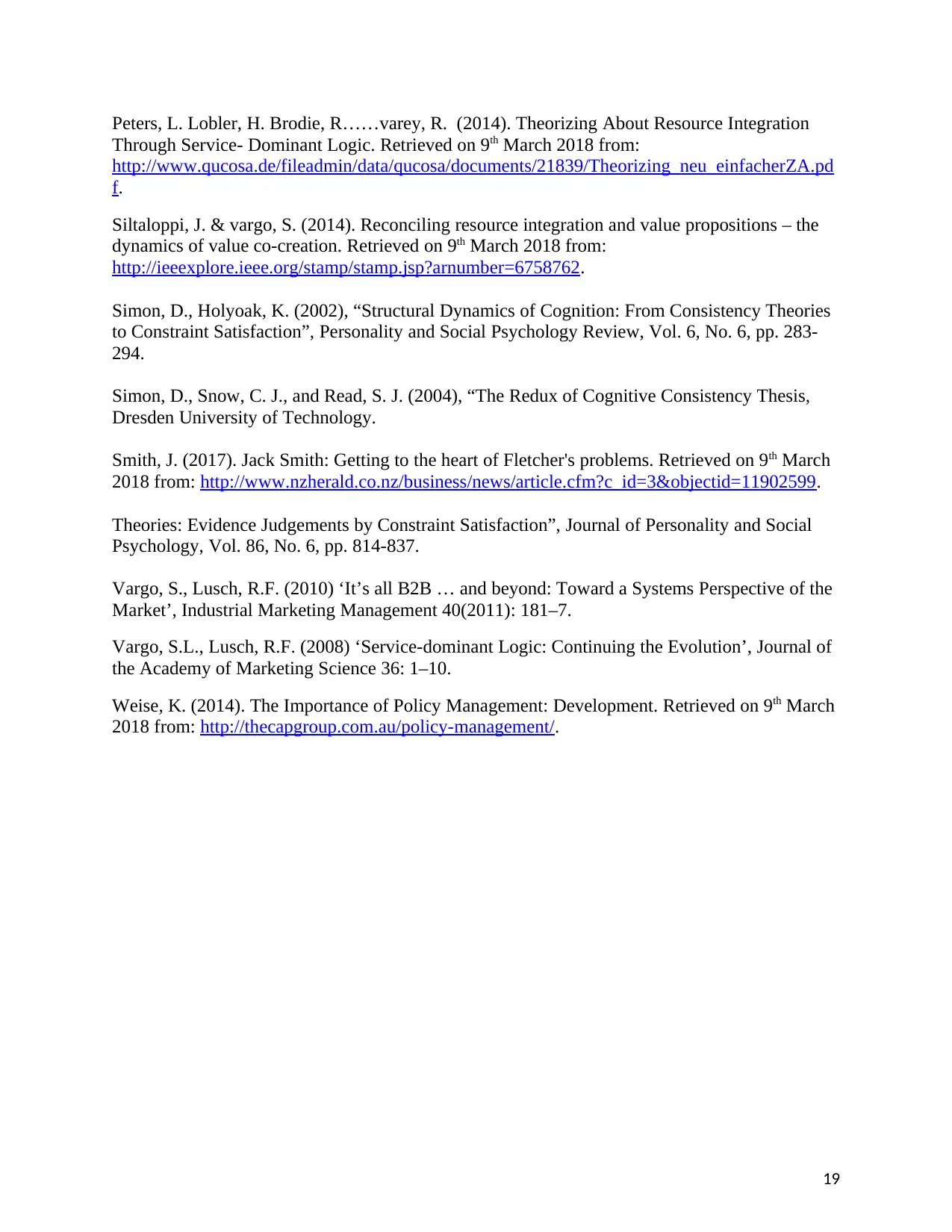
Peters, L. Lobler, H. Brodie, R……varey, R. (2014). Theorizing About Resource Integration
Through Service- Dominant Logic. Retrieved on 9th March 2018 from:
http://www.qucosa.de/fileadmin/data/qucosa/documents/21839/Theorizing_neu_einfacherZA.pd
f.
Siltaloppi, J. & vargo, S. (2014). Reconciling resource integration and value propositions – the
dynamics of value co-creation. Retrieved on 9th March 2018 from:
http://ieeexplore.ieee.org/stamp/stamp.jsp?arnumber=6758762.
Simon, D., Holyoak, K. (2002), “Structural Dynamics of Cognition: From Consistency Theories
to Constraint Satisfaction”, Personality and Social Psychology Review, Vol. 6, No. 6, pp. 283-
294.
Simon, D., Snow, C. J., and Read, S. J. (2004), “The Redux of Cognitive Consistency Thesis,
Dresden University of Technology.
Smith, J. (2017). Jack Smith: Getting to the heart of Fletcher's problems. Retrieved on 9th March
2018 from: http://www.nzherald.co.nz/business/news/article.cfm?c_id=3&objectid=11902599.
Theories: Evidence Judgements by Constraint Satisfaction”, Journal of Personality and Social
Psychology, Vol. 86, No. 6, pp. 814-837.
Vargo, S., Lusch, R.F. (2010) ‘It’s all B2B … and beyond: Toward a Systems Perspective of the
Market’, Industrial Marketing Management 40(2011): 181–7.
Vargo, S.L., Lusch, R.F. (2008) ‘Service-dominant Logic: Continuing the Evolution’, Journal of
the Academy of Marketing Science 36: 1–10.
Weise, K. (2014). The Importance of Policy Management: Development. Retrieved on 9th March
2018 from: http://thecapgroup.com.au/policy-management/.
19
Through Service- Dominant Logic. Retrieved on 9th March 2018 from:
http://www.qucosa.de/fileadmin/data/qucosa/documents/21839/Theorizing_neu_einfacherZA.pd
f.
Siltaloppi, J. & vargo, S. (2014). Reconciling resource integration and value propositions – the
dynamics of value co-creation. Retrieved on 9th March 2018 from:
http://ieeexplore.ieee.org/stamp/stamp.jsp?arnumber=6758762.
Simon, D., Holyoak, K. (2002), “Structural Dynamics of Cognition: From Consistency Theories
to Constraint Satisfaction”, Personality and Social Psychology Review, Vol. 6, No. 6, pp. 283-
294.
Simon, D., Snow, C. J., and Read, S. J. (2004), “The Redux of Cognitive Consistency Thesis,
Dresden University of Technology.
Smith, J. (2017). Jack Smith: Getting to the heart of Fletcher's problems. Retrieved on 9th March
2018 from: http://www.nzherald.co.nz/business/news/article.cfm?c_id=3&objectid=11902599.
Theories: Evidence Judgements by Constraint Satisfaction”, Journal of Personality and Social
Psychology, Vol. 86, No. 6, pp. 814-837.
Vargo, S., Lusch, R.F. (2010) ‘It’s all B2B … and beyond: Toward a Systems Perspective of the
Market’, Industrial Marketing Management 40(2011): 181–7.
Vargo, S.L., Lusch, R.F. (2008) ‘Service-dominant Logic: Continuing the Evolution’, Journal of
the Academy of Marketing Science 36: 1–10.
Weise, K. (2014). The Importance of Policy Management: Development. Retrieved on 9th March
2018 from: http://thecapgroup.com.au/policy-management/.
19
1 out of 19
Related Documents
Your All-in-One AI-Powered Toolkit for Academic Success.
+13062052269
info@desklib.com
Available 24*7 on WhatsApp / Email
![[object Object]](/_next/static/media/star-bottom.7253800d.svg)
Unlock your academic potential
© 2024 | Zucol Services PVT LTD | All rights reserved.





